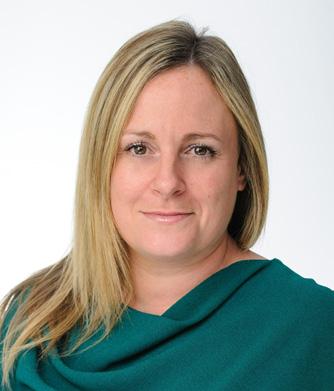
MORTGAGE INTRODUCER Champion of the Mortgage Professional www.mortgageintroducer.com January 2023 £5 STATE OF THE NATION A look at the year ahead MORTGAGE INTRODUCER AWARDS The night of nights for the mortgage industry

MORTGAGE INTRODUCER JANUARY 2023 www.mortgageintroducer.com We know that every case is different and whilst some lenders may not be able to help, we see the potential and cut through complexity. Our strength lies in our flexible common sense approach with a willingness to consider cases that fall outside of our standard criteria. Our underwriters individually assess each case enabling us to find tailored solutions for your buy to let and residential clients. The home of mortgage solutions andcr a fted pecialist BUY TO LET AND RESIDENTIAL MORTGAGES Flexi b le CRITERIA AND UNDERWRITING Individual CASE ASSESSMENT Empowered NATIONAL BDMs TO SUPPORT YOU andcr a fted Call us today on 01634 888260 or visit krfi.co.uk to find your BDM. FOR INTERMEDIARIES ONLY Information correct at time of print (20.01.2023)
Managing Editor
Paul Lucas paul.lucas@keymedia.com
Editor

Simon Meadows simon.meadows@keymedia.com
News Editor
Jake Carter jake.carter@keymedia.com
Commercial Director
Matt Bond matt.bond@keymedia.com
Advertising Sales Executive
Jordan Ashford jordan.ashford@keymedia.com
Campaign Coordinator
Raniella Alonzo raniella.alonzo@keymedia.com
Content Editors
Kel Pero, Christina Jelinek
Production Manager
Monica Lalisan
Production Coordinators Kat Guzman, Loiza Razon
Designers
Khaye Cortez, Allen Dela Paz
Head of Marketing
Robyn Ashman robyn.ashman@keymedia.com
Marketing Executive - Awards
Princess Capili
Forward thinking
Anew year always brings with it a sense of renewal – a seasonal permission, as it were, to look ahead, embrace the fresh twelve months that lie before us, and take the opportunity, if you wish, to move forward with a new resolve. All of this is good, fantastic, life-affirming stuff, and you’ll find no objections here to doing just that.
But it’s important to take stock, too, to get a true sense of where we are and how we’re performing, in readiness for whatever 2023 holds. This month’s Mortgage Introducer does just that, taking the temperature, if you like, of a profession that was truly tested by the economic turbulence of 2022, particularly in the final few months of the year.
“State of the Nation” has become a staple annual feature in the magazine. From the expert team at Just Mortgages, we get an excellent, first-hand appraisal of the industry, in the words of its brokers, delivering their rich insights from vantage points across the length and breadth of Britain.
They’re honest about some of the challenges they have faced, but inspiring, too, in their confidence in the market and their optimism about the business they will do in the coming year.
KM Business Information UK Ltd
Signature Tower 42, 25 Old Broad Street Tower 42, London EC2N 1HN www.keymedia.com
UK ∙ Canada ∙ Australia ∙ USA ∙ NZ ∙ Asia
Mortgage Introducer is part of an international family of B2B publications, websites, and events for the mortgage industry
CANADIAN MORTGAGE PROFESSIONAL cmpadvertise@keymedia.com
MORTGAGE PROFESSIONAL AMERICA mpaadvertise@keymedia.com
MORTGAGE PROFESSIONAL AUSTRALIA claire.tan@keymedia.com
AUSTRALIAN BROKER simon.kerslake@keymedia.com
NZ ADVISER alex.rumble@keymedia.com
Copyright is reserved throughout. No part of this publication can be reproduced in whole or part without the express permission of the editor. Contributions are invited, but copies of work should be kept, as the magazine can accept no responsibility for loss.
We also bring you extensive coverage of our coveted Mortgage Introducer Awards – an unapologetically celebratory night that shone a light on the brightest and best of the profession, recognising those who define the excellence that can be found at every level of the business, from rising stars to a long-established, lifetime achiever.
The glittering event in London showcased an industry in good heart, keen to acknowledge the successes of the past year and inspire others who wish to follow in the footsteps of the winners by attaining such illustrious accolades themselves.
To speak with the winners just moments after they picked up their awards was an absolute pleasure; their excitement and joy were palpable, and their enthusiasm for their work was infectious, with a positivity of the kind upon which great years are made.
Here’s hoping for more of the same in 2023.
Simon Meadows
www.mortgageintroducer.com JANUARY 2023 MORTGAGE INTRODUCER
COMMENT
EDITORIAL
1












MORTGAGE INTRODUCER JANUARY 2023 www.mortgageintroducer.com WHAT’S INSIDE MAGAZINE Contents 4 Market review 9 Advice review 14 London review 15 Recruitment review 16 Technology review 20 Protection review 25 General Insurance review 28 Cover Feature: State of the Nation Brokers’ takes on what’s ahead 36 MI Awards Shining brightly 46 Jordanne Whiley From tennis to finance 48 Loan Introducer Talking to Specialist Finance Centre’s Daniel Yeo, and the latest from the second-charge market 52 Specialist Finance Introducer Spotlight on Ryan Brailsford of Pepper Money UK, and more on the buy-to-let specialist market 58 Bridging Introducer Experts’ predictions for 2023, spotlight on the Norton Group’s Sonny Gosai, and bridging market reviews 2 23 The MI Awards 36 Consumer duty 13 54 Housing supply still tight Looking up



























The intermediary market will be in great demand this year

million fixed-rate mortgage deals were scheduled to end in 2023. The trade body also forecast that around £212bn of product transfers would take place over the course of 2023, compared with an estimated £197bn in 2022.
2023 is set to be an intriguing 12 months for the housing and mortgage markets, on the back of a year that saw many highs as well as a few lows.
Over the past few years, we’ve learned not to get too far ahead of ourselves, as circumstances and scenarios can turn in an instant. However, as a lender, we also have to be prepared – when and where possible – to adapt quickly to economic and market trends as they occur – although predicting the future is certainly not easy.
When it comes to a considered and highly valued approach to potential lending figures for the year ahead, there are strong barometers that we can tap into. In late 2022, UK Finance published its mortgage market forecast for 2023–2024, which anticipated a softening in the mortgage market and a return to prepandemic norms.
This outlined that overall mortgage lending was expected to fall 15 per cent in 2023, compared to 2022 figures. Breaking this down, purchase lending was predicted to drop by 23 per cent, due to cost-of-living pressures and rising interest rates, placing pressure on affordability, while new lending to buy-to-let landlords was projected to fall by 27 per cent.
UK Finance expected the number of property transactions to fall by 21 per cent in 2023 (from around 1.2 million in 2022 to 1 million this year). However, it did expect to see strong demand for refinancing, as around 1.8
Further data from IMLA has suggested that inflation will be a key factor in determining the UK mortgage market’s prospects over the next two years. IMLA’s New ‘Normal’ – Prospects for 2023 and 2024 report predicted that higher interest rates would result in gross mortgage lending falling to £265bn in 2023 and £250bn in 2024. Buy-to-let lending was also expected to fall to £47bn in 2023 as a tougher economy weighed on the market.
More positively, the report did suggest that, in some respects, the effects of the cost-of-living crisis on homeowners might not be as severe as expected. It predicted that the number of households in negative equity would only reach 16,000 by Q4 2024, with an average negative figure of £4,300 per household, despite many experts drawing comparisons between the current situation and the housing downturn of the 1990s, when up to 1.8 million households were in negative equity.
This was said to be due to a lower proportion of lending at high LTVs, rapid house price rises since the COVID-19 pandemic, and a greater uptake of capital repayment mortgages, meaning more borrowers had paid down their mortgage balance. These factors, combined with more rigorous lending criteria and enhanced lender forbearance, meant that actual possessions figures were expected to be less than half of those reported in 2009.
In terms of house prices, a number of predictions have emerged in recent times, ranging from an aggressive slump to a more subdued slide. The national view from Zoopla
was that UK house prices were likely to fall by five per cent in 2023. It also added that price falls in the more affordable markets were likely to be below average as the hit to buying power from higher mortgage rates would be less than in the highvalue markets. This was supported by the evidence of continued aboveaverage demand in more affordable urban areas. In addition, Rightmove projected that average asking prices would decline by two per cent, which meant prices would remain higher than they were after the incredibly busy home-moving period of 2021.
With mortgage rates steadily falling and encouraging signs of further stability from an overall economic perspective, it will be interesting to chart demand from first-time buyers and second-steppers in Q1 2023. High inflation levels and sustained cost-ofliving pressures will continue to affect an array of borrowers, and this will place an increased emphasis on the value of the advice process and the role played by the intermediary market.
This was evident in the aforementioned IMLA report, which outlined that the lion’s share of mortgage business in 2022 was conducted through intermediaries, with their share of distribution rising from 80 per cent to 84 per cent. IMLA expected this share of the market to grow to 90 per cent by 2024.
We have seen just how resilient and robust the UK housing and mortgage markets were in the latter part of 2022, and we are now in a new year that is likely to generate as many opportunities as it does challenges. This is especially apparent for an intermediary market, whose levels of experience and expertise will be so highly prized and in such great demand. M I
MORTGAGE INTRODUCER JANUARY 2023 www.mortgageintroducer.com 4
REVIEW MARKET
Martin Clift head of intermediary services & transformation, Barclays













































































































How limited company lending can be expected to grow

cost of food. Homeowners are more concerned about rising energy prices (73 per cent) than those who don’t own their own homes (66 per cent).
In the wake of rising inflation and cost-of-living expenditure, it’s clear that many people are having to make important financial decisions and lifestyle choices.
For those who are harbouring homeownership aspirations, their ability to save for a deposit has become increasingly narrowed over the past six to twelve months, if not longer in some cases. A further avenue has also recently been closed in the form of the Help to Buy scheme, at least in England.
Thankfully, options do remain available through shared ownership, intergenerational lending, and additional government and lender-led initiatives. However, affordability remains one of the largest hurdles facing first-time buyers and second-steppers.
This was found to be the case in the latest property survey from the Building Societies Association (BSA), which highlighted that twothirds (66 per cent) of respondents cited the affordability of mortgage repayments as the biggest obstacle to buying a property. Over half (53 per cent) said concerns about raising a deposit were blocking them, while access to a large enough mortgage was reported to be the third-biggest barrier, selected by almost half (45 per cent) of respondents.
Focusing on affordability concerns among homeowners and renters over the next six months, 70 per cent are worried about rising energy prices and 63 per cent about the rising
When asked about affordability of monthly mortgage or rent payments over the next six months, the vast majority (87 per cent) of mortgage borrowers did not express concern about keeping up with their mortgage payments. Renters were less confident, with around a quarter (23 per cent) expressing concern about meeting their housing costs.
This heady combination of factors will inevitably place an even greater emphasis on the private rented sector (PRS) as a growing number of potential buyers are having to lower expectations or even postpone their homeownership plans, at least for now.
In light of some of the more immediate homeownership plans being scuppered, existing tenants may have to rent for longer. This will only add to already congested levels across the PRS as the next wave of renters emerges, putting further pressure on what is already limited rental housing stock. The result is likely to be a vicious circle leading to even stronger levels of demand, increased rents, and further affordability concerns.
On paper, at least, this may appear to be the perfect storm for landlords, as it offers the licence to increase yields and bolster their profit margins. However, it’s certainly not as simple as this. Many landlords have been hit hard in recent times due to helping tenants through the pandemic and increased regulatory and tax demands, and they have also been subject to a host of rising costs. They also rely on good tenants who can afford the rents that they impose, which leads us back to that vicious circle.
It’s no secret that many amateur or accidental landlords have sold properties due to some or all of the aforementioned issues. It’s also the case that all landlords are having to re-evaluate portfolios, diversify if necessary, and find ways to maximise individual and collective investments, a trend that will continue in 2023.
As such, it came as no surprise to see that 75 per cent of landlords operating in the UK have now used a limited company to invest in at least one of their investment properties. This was according to a poll from GetGround, which added that external market events are driving adoption of limited companies by landlords.
The data found that 93 per cent of landlords surveyed who incorporate their property investments said that if it were not for the limited company structure, their investments would be less profitable while mortgage rates remain high.
Meanwhile, 57 per cent of landlords say the limited personal liability is a key benefit of incorporation, protecting them against the higher risk of missed rental payments in the current costof-living crisis. The same percentage of landlords believe using limited companies to enable co-investment among multiple people is a second key advantage, creating a path around the not-insignificant cost of entering the investment market.
Limited company lending is an area that has grown steadily in recent years, and it’s reasonable to expect that adoption levels will continue to accelerate. This is an ongoing trend on which intermediaries need to be fully versed, as the emphasis will remain on professional and portfolio landlords in the BTL market through 2023 and beyond. M I
MORTGAGE INTRODUCER JANUARY 2023 www.mortgageintroducer.com 6
REVIEW MARKET
Cat Armstrong mortgage club director, Dynamo for Intermediaries

For the use of mortgage intermediaries and other professionals only. The information contained in this article is the property of Lloyds Banking Group plc and may not be reused or publicised without our prior permission. The information provided is intended to be for information only and is not intended to be relied upon. This information is correct as of November 2022 and is relevant to Halifax products and services only. If you do not have professional experience, you should not rely on the information contained in this communication. If you are a professional and you reproduce any par t of the information contained in this communication, to be used with or to advise private clients, you must ensure it conforms to the Financial Conduct Authority’s advising and selling rules. Halifax is a division of Bank of Scotland plc. Registered in Scotland No. SC327000. Registered Office: The Mound, Edinburgh EH1 1YZ. Bank of Scotland plc is authorised by the Prudential Regulation Authority and regulated by the Financial Conduct Authority and the Prudential Regulation Authority under registration number 169628. The harder it gets out there, the harder we try to make things easier. Find out more at halifax-intermediaries.co.uk
2023 is about staying true to our purpose
challenges first-time buyers now face.
For hundreds of thousands of would-be first-time buyers, the dream of homeownership may appear to be fading just a little bit more as each month passes. Eye-wateringly high energy bills and the significantly higher cost of food, clothes, and daily living have eliminated many first-time buyers’ ability to save further. Compounding this has been the rise in average mortgage rates, which inevitably puts pressure on affordability.
It’s a triple whammy, hurting the size of deposit and making monthly repayments almost unaffordable. Slowing house-price inflation offers moderate mollification, but homes remain extremely expensive compared to incomes. Those now unable to buy would be forgiven for feeling not just disappointed but seriously frustrated. For more than a decade, mortgage rates have been low, making it cheaper to buy than rent if you’re talking monthly outgoings. But, after more than 13 years, it’s easy to forget that it wasn’t always like this.
For first-time buyers in their 20s and even early 30s, it may be hard to believe that interest rates have been much higher than 5.75 per cent. The periods of high inflation and high mortgage rates happened well before they’d left school or university. Buyers will also have seen the Help to Buy scheme cease at the end of October, spelling the end of government support in keeping mortgage costs down. However, hope is not gone. The nature of the market has changed, and rapidly, yet there are ways around the new
As a building society that is powered by our purpose, helping people own their own homes is fundamental. We believe it’s vital that lenders like us not abandon those hoping to purchase property over the coming year, no matter how bleak the economic situation in which we find ourselves seems to be. Given the pressure on those saving for a deposit, our savings range is rewarding customers with much higher rates – going some way to counter the
supported buyers who couldn’t make use of Help to Buy because of the price caps imposed across England. The other huge advantage of the scheme is that, being industry-led, its support to low-deposit buyers cannot be withdrawn by government – a very reassuring consideration in the current fiscal situation – and we have maintained our commitment to those hoping to buy with lower deposits through Deposit Unlock.
effects of inflation. Yet we also recognise that saving tens of thousands of pounds or even more is simply not practical or possible for many first-time buyers –now more so than ever.
We’ve always been committed to supporting higher loan-to-value lending, and that remains the case today. Even before the Help to Buy scheme closed to new applications, we were the first lender to offer the Deposit Unlock scheme, and remain one of just three. Launched in collaboration with the Home Builders Federation and Gallagher Re, the scheme enables firsttime buyers and existing homeowners to purchase a new-build home for up to £750,000 with a five per cent deposit. The scheme has been hugely successful already, with around 75 per cent of the applications we’ve seen coming from first-time buyers.
Through it, we have also
We’ve also seen strong uptake on First Homes, the long-awaited scheme that allows first-time buyers to purchase a home at a minimum discount of 30 per cent and a maximum of 50 per cent – a benefit that stands with title. As affordability pressures endure, and quite possibly mount in the course of 2023, that discount is considerable. Although the scheme is reasonably restrictive on eligibility, there’s no doubt it is working to keep people in their local communities – even where house prices have risen. We also recently launched a range of standalone products to support the shared ownership market, enabling those on joint incomes up to £80,000 (£90,000 in London) to get onto or move up the property ladder.
In January last year, I wrote that the cost-of-living crisis would dominate throughout 2022. It has, but it has been much, much worse than anyone could have predicted then. 2023 is going to be just as tough – tougher, perhaps. But we will get through it, as we got through the credit crunch and its aftermath, and through the pandemic. As we begin another year, we must not lose sight of the things we can do amid those we can’t. There are far more reasons to be hopeful than it might seem. At Newcastle, our ongoing promise to help buyers realise their dreams of homeownership is just one of them. M I

MORTGAGE INTRODUCER JANUARY 2023 www.mortgageintroducer.com 8
REVIEW MARKET
Stuart Miller board member / chief customer officer, Newcastle Building Society
“In January last year, I wrote that the cost-ofliving crisis would dominate throughout 2022. It has, but it has been much, much worse than anyone could have predicted then”
Talking to clients about protection during the cost-of-living crisis
DUTY OF CARE
The rules contained in the new consumer duty include requirements to
act in good faith
avoid causing foreseeable harm
enable and support customers to pursue their financial objectives
Increases in mortgage interest rates, bills, and general household expenditure have placed many borrowers under pressure. Some will consider cancelling their protection cover; others will resist discussing their protection needs at all.
Nevertheless, as a mortgage adviser you have a responsibility to make sure that your customers are aware of the implications of any decisions they make. This duty of care to your customers, in the current cost-of-living crisis, is arguably greater than ever.
In a recent survey by Guardian Financial Services, 62 per cent of advisers said they believed that, as a result of the pandemic, there was still an increased willingness among customers to talk about protection. Conversely, however, 56 per cent expected the rising cost of living to reverse this trend.
This could be because so many consumers underestimated how long it would take them to run out of money if they lost their means of income. The latest Legal & General Deadline to Breadline report reveals that, on average, most think they could survive for 60 days. The true figure is just 19 days.
That discrepancy is a stark reminder of how much guidance customers need to fully understand the implications – for them and their families – of not having the right protection in place.
How can you meet these expectations if you don’t discuss protection with every single one of your customers? If you don’t, and something goes wrong, you may find yourself having to explain why you didn’t mention protection when discussing mortgages. And it’s not simply a case of sharing your knowledge with your customers; you’ll need every communication skill in your armoury to ask difficult questions
empathise, listen, and fully understand their needs
provide and explain solutions and your recommendations

WHY SOME CUSTOMERS MAY BE RELUCTANT TO PAY FOR PROTECTION
One of the key challenges when discussing personal protection – such as life assurance, critical illness, or income protection – is a perception that it’s an added expense. It’s not mandatory, whereas some luxuries, like subscriptions to streaming services, are often subject to contracts of 12 months or longer. So, many customers do not see these as optional outgoings, but may perceive protection cover as an additional expense.
The other reason customers may be reluctant to pay for protection products is they don’t receive anything tangible unless something goes wrong. And many customers don’t consider the probability, or even the possibility, that
something may go wrong for them.
There are also misconceptions about how the state will help people in times of financial need. Again, your role is to support and educate your customers. So, if your knowledge of state benefits has any gaps, it may be time to address them – and quickly.
Some people believe family will bail them out if they are in financial difficulty. But is this really the case?
ASKING THE RIGHT QUESTIONS
To get a complete picture of your customers’ circumstances, conduct a thorough fact-find to identify all their assets, liabilities, income, and outgoings. It is also a good opportunity to ask them which of their outgoings are contractually committed and which are optional.
Make sure you listen actively – repeat back to them what they say to ensure you have a clear understanding, maintain eye contact, and use positive body language.
Identify their aspirations, their priorities, and their concerns. Here it’s also important to recognise that their priorities are likely to be different from yours.
Building rapport with your customers in this way will make it easier to touch on the sensitive subjects. You need to ask them to consider their financial security, and what would happen to their mortgage payments, in worst-case scenarios. That means making them think about the possibilities that none of us wants to face – such as losing your livelihood, critical illness, and even death. It may feel like a big ask. But if you can empathise with your customers, you can guide them toward the right solutions for themselves and their families. That could be their lifeline in the years to come, and it’s one for which they’ll thank you. M I
www.mortgageintroducer.com JANUARY 2023 MORTGAGE INTRODUCER 9
REVIEW ADVICE
Gordon Reid business and development manager, The London Institute of Banking & Finance
The future for longer-term, fixed rates
12 months will be facing a serious financial hit. For some, that will be a debilitating blow that will leave them unable to afford their payments.
There are key moments for any industry, when the tide turns and everything you thought you knew suddenly needs a bit of a rethink.
For more than a decade, interest rates have been virtually non-existent. Getting a mortgage was a case of saving for a deposit; monthly payments were often lower for owners than for renters.
But things have turned upside down. Savers can find reasonable rates, particularly if they’re prepared to take a fixed-term bond (albeit as I write, rates have softened), so the new norm still has some way to go before we’re settled. So, while no one would suggest this is a windfall, first-time buyers stashing away as much as they can to build their deposit are being helped along by higher interest rates than have been seen in 10 years or more.
Borrowers, on the other hand, now face a much tougher challenge when it comes to affordability. Suddenly rates have gone from sub–one per cent to over six per cent. The effect on monthly mortgage payments is nauseating for anyone pushing their financial limits.
In fact, it takes homeownership off the table for huge numbers of people – even those who have their deposit in the bank.
The media frenzy that followed the former chancellor’s now-defunct mini budget fuelled rising panic among borrowers. But many commentators make a justified point: Anyone heading toward the end of their fixed rate and who needs to remortgage in the coming
Putting a pin in the question of affordability for a moment, I think we need to have a good think about what borrowers now think they want. Because, as all brokers know, what they think they want might not actually be what they really want –or need.
Moneyfacts published some figures on 17 October, when Jeremy Hunt was confirmed as Kwasi Kwarteng’s replacement. Markets reacted reasonably benignly that day. Nonetheless, forward-looking markets retained their cautious stance.
Swaps stayed high – inflation is a dead cert no matter who’s in Number 11– and the average two-year fixedrate mortgage, across all loan-tovalue brackets, hit 6.47 per cent. The average five-year fix was, by stark contrast, 6.29 per cent.
For years and years now, the message from experts, advisers, and the market in general has been that fixed rates mean certainty. Long-term fixed rates make less sense if you think interest rates will stay low or fall. Short-term fixed rates in a stable rate market are probably the optimum balance between certainty and flexibility.
Does that logic still stand in today’s market? Judging from the conversations I’ve been having with colleagues, advisers, investors, and friends, there has been a marked shift from two-year fix enquiries to five-year fixes and much longer. More recently, those enquiries have translated to applications and completions.
This reflects a number of things: people are terrified about energy bills, interest rates, and the undeniably higher cost of living, and they want at least something to be certain. It’s
human nature. When faced with the unknown, we try to make as much of it known as possible. It’s risk maagement. There will be clients for whom the certainty of a long-term fix is absolutely the right thing. For others, it may well be a very expensive mistake, should they have to repay early. Indeed, if the market is moving to longer-term fixes, then there is even more argument that these should be available without costly early repayment charges (ERCs).
If a ten-year fix is available without penalties, compared to a five-year fix, then it surely offers the best of both worlds: certainty of repayments over a longer period and flexibility to move house or pay off your mortgage early. ERCs become a cost of the product –that should be understood at the point of sale, if there is a likelihood that they may be paid because of life’s changes along the way.
Timing is also a considerable risk. Lock in for five years with ERCs, and who knows where we’ll be? Borrowers may need the security of a longer-term fix (and may enjoy greater affordability to boot), but they do not need the complete inflexibility that accompanies that decision if their circumstances change.
In just seven short months, the FCA’s consumer duty will be in play, and that means we all must be considering what good outcomes for our clients look like now. And if the past six months have taught us anything, it’s that things change at speed, and perhaps our original view of a good outcome needs to evolve.
As an industry, we need to make sure our rhetoric matches the real needs borrowers face in a market that has changed out of all recognition. We need to strike a new balance of lowest rate, certainty, flexibility, and affordability. M I

MORTGAGE INTRODUCER JANUARY 2023 www.mortgageintroducer.com 10
REVIEW ADVICE
Tim Hague MD, Sagis
For the next generation of home owners
Up to 95% LTV on New Build Houses
Joint Borrower, Sole Proprietor (with up to 4 applicants)
40-year mortgage terms available
Mortgages designed with first time buyers in mind.

Find out more at skipton-intermediaries.co.uk
For Intermediary Use Only
321112_09/01/23
Filling the energy-efficiency knowledge void

and most cost-effective ways to improve the energy efficiency of a property is to seal air leaks. Caulk can be used to seal gaps around windows and doors, and weatherstripping to seal gaps around door frames.
With increased complexity coursing through the homebuying journey, the green-mortgage market rapidly evolving, and energy efficiency rising to the forefront of homeowner and landlord agendas, an increasing number of clients are seeking additional support from a sustainability, economic, and environmental perspective.
Here at Countrywide Surveying Services (CSS), one of our main goals is to provide guidance and information to UK homeowners on the impact of the significant climate change challenge, with an aim of reducing emissions. With additional EPC-related legislation pending, energy efficiency is also high on the agenda for landlords. And let’s not forget the growing number of tenants who are focusing on how, where, and when energy-related savings can be made in such a challenging economic climate. This trend is making more and more landlords sit up and take note from a demand and longevity of tenancy perspective.
RETROFITTING
Clients can reduce their environmental impact and save money on energy costs today and in the future by retrofitting. However, this may seem like a daunting prospect for many, especially when it comes to understanding which practices and processes can make the biggest impact – not to mention the cost implications. Thankfully, there are some lower-cost options that advisers can share with homeowners and landlord clients.
1. Seal air leaks: One of the easiest
2. Replace light bulbs: Switching to LED light bulbs can significantly reduce energy consumption and save money on energy bills. LED bulbs are more expensive upfront, but they last longer and use less energy than traditional incandescent bulbs.
3. Install a programmable thermostat: A programmable thermostat offers the ability to better control heating and cooling systems when one is in and out of the property.
4. Insulate the hot water heater: Adding insulation to hot water heaters can reduce heat loss and improve the efficiency of the appliance. This is a relatively inexpensive and easy DIY project that can pay off handsomely in energy savings.
5. Use energy-efficient appliances: When it’s time to replace appliances like a refrigerator or washing machine, opt for Energy Star-certified models. These appliances are more energy efficient and can save money on energy costs over time.
By implementing these low-cost retrofits, homes can quickly become more energy efficient and reduce their carbon footprint – without breaking the bank.
If clients are thinking of investing more:
1. Insulating the home: Proper insulation can significantly reduce energy loss, improve energy
efficiency, and keep homes warm in the winter and cool in the summer.
2. Replace old windows: Replacing older windows with energyefficient windows can help reduce heat transfer and improve insulation.
3. Install low-flow fixtures: Lowflow showerheads and faucets can significantly reduce water usage and save money on water bills.
4. Go solar: Solar panels can provide an alternative source of energy for homes and help reduce reliance on fossil fuels. While the initial investment may be steep, solar panels can save money on energy costs in the long run.
5. Landscape for sustainability: People should consider adding native plants to landscaping, as they require less water and maintenance. Rainwater collection systems can also be installed to capture and reuse rainwater for irrigation.
With these retrofit measures, homeowners and landlords can make their properties more sustainable and efficient.
What’s our role in filling the energyefficiency knowledge void? In March 2021, we launched EnergyFact in partnership with Santander, which is designed to help homeowners assess and identify potential property improvements to enhance energy efficiency. The report does not require a surveyor’s visit and is generated through a new, dedicated online portal.
The energy report provides customers with suggested improvements, the cost of completing the work, and an estimate of resulting savings on energy bills. The report also suggests small changes customers can make to their lifestyles.
By raising awareness around these issues, advisers can contribute to the creation of a more sustainable and responsible future. M I
MORTGAGE INTRODUCER JANUARY 2023 www.mortgageintroducer.com 12
REVIEW ADVICE
Kharla Mullen chief operating officer, Countrywide Surveying Services
Looking beyond the headlines
tell the whole story when it comes to measuring local market conditions.
What does 2023 have in store for us? Rather than the roaring 20s of a century earlier, the UK is facing yet another year of financial frugality.

The Bank of England has made it clear we’re in for a two-year recession. Interest rates ended 2022 at 3.5 per cent, and we’ve got more hikes to go.
Even as higher rates begin to put a lid on inflation, it’s going to be painful. Considerable damage has already been done, and there are millions of people grappling with difficult circumstances.
But I am of the view that in the housing market, at least, we shouldn’t be quite as worried as some are suggesting.
When interest rates rise and the global economy is in the proverbial, people begin to murmur. Almost the first question when recession hits, especially in the UK, is, “Will there be a house price crash?”

Talk of a global property crash is getting louder, with a recent article in The Economist noting falls in nine rich economies.
America’s house-price inflation is coming off the boil, gently so far. Where the price of homes has risen insatiably, the falls have been more significant. At the time of writing, Canada’s house prices are down nine per cent since last February. Tighter monetary policy is putting pressure on borrower affordability around the world. As average prices come down, buyers demand hefty discounts and sellers are forced to accept lower offers.
Sounds bad, but you could argue that it’s really a load of rubbish. The dynamic does change in favour of buyers, but averages don’t always
What does matter in this equation is the affordability factor. As is obvious, the rising cost of living has, in just weeks, wiped out some people’s ability to buy. In January of last year, mortgage rates stood at 1.42 per cent and peaked in October at 5.93 per cent. This increase in rates saw the average buyer experience a 38 per cent fall in buying power over 2022, when a monthly payment of £852 in January meant a home worth £356,000, compared to £219,000 in October.
But, ultimately, there are two reasons not to be too gloomy about the outlook for our housing market: supply and demand.
Just as the oversupply of homes in a concentrated area pulls prices down, so the undersupply of appropriate homes supports values.
Supply has not only failed to meet the number of new homes required to house Britain’s growing population, but it has also failed to reflect the significant shift in the sort of homes that population needs.
From a builder’s point of view, developments with lots of five-bedroom executive homes and just the requisite percentage of affordable housing make the biggest profit. Ergo, more big homes, more expensive homes.
It’s contrary to the housing needs we have in the UK, however. Office for National Statistics data shows an estimated 28.1 million households in the UK in 2021, an increase of 6.3 per cent over the past 10 years.
Crucially, the number of people living alone in the UK has risen faster than this, up 8.3 per cent over the past 10 years.
It’s not a coincidence that in 2021, the proportion of one-person households ranged from 25.8 per cent in London to 36 per cent in Scotland.
House prices are almost out of reach for single households in the capital. Even with a substantial deposit, loan-
to-income ratios scaling 10 times are needed to secure a mortgage.
Where prices are less drastically out of sync with incomes, the proportion of those able to afford to buy on their own is much higher.
This tells us both where the market is broken (well, it tells us one of the places it’s broken) and why that will keep a floor under house prices.
Compared to demand, supply of the right type of homes is shrinking. It shows in the figures: in 2021, 3.6 million people aged 20 to 34 years were living at home with their parents. That is a whopping 28 per cent of people in this age group, an increase from 24 per cent a decade ago.
Until we address the inadequate housing mix across the country and match it to demand in the appropriate locations, prices will remain high relative to affordability. The only bit you need to be worried about is where that mix already matches. M I
www.mortgageintroducer.com JANUARY 2023 MORTGAGE INTRODUCER 13
REVIEW ADVICE
Steve Goodall MD, e.surv
Seeing the wood for the trees
Robin Johnson MD, KFH

Another year, another rollercoaster ride for house prices. In mid-December, Halifax published its November house price index, which showed that, true to form, London recorded the slowest rate of annual house-price growth of any UK region in 2022.
The capital saw the average house price rise by 5.2 per cent over the year to November, though let’s not be too despondent about it. At £549,160, London still has by far the most expensive average UK property price.
I do think it’s worth reminding ourselves that house price inflation of more than five per cent in a year, notwithstanding that rate being the slowest among all regions, is pretty extraordinary.
In a city where the average –average – house price has tipped over the half-million-pound mark, that is a very significant rise in value over just 12 months.
In its same report, Halifax said it was expecting an eight per cent drop in average house prices in 2023. They may prove right, but remember that few people purchase property with the intention of selling it again in the next 12 to 24 months.
Both homes and buy-to-let investment properties are bought and kept. And as any fund manager worth his or her salt (and complying with the Financial Conduct Authority rules) will tell you, the value of your investment can go down as well as up.
In the next breath you’ll hear the old adage that it’s not about timing the market; it’s about time in the market. Cliches they may be, but they’re
cliches for good reason. Capital values are wont to fluctuate, and property is no different. If you are buying to flip, an eight per cent drop in values might wipe out your investment case. If, on the other hand, you’re buying to live somewhere for the next five years and you can afford the mortgage, get on with it.
That’s even more pertinent when you consider what is going on in the private rented sector at the moment. It is a market very out of sorts. The concatenation of tax relief reform, energy efficiency standards, higher interest rates, and increasing pressure from institutional landlords has wrought havoc for private landlords over the past five years.
the average London asking rent rose to £2,343 per calendar month in Q3 2022, the biggest-ever annual jump at 16.1 per cent.
The property portal said there were now more new rental properties available everywhere in the country except London – but even so, tenant demand still greatly outweighs the number of homes available to rent.
Rightmove puts tenant demand up by a massive 20 per cent per cent compared with last year. By comparison, the number of properties available to rent is down nine per cent, setting competition among tenants at a record high.
What do all these numbers mean for London residential property? In brief:
1. Ultra-prime property values affect the averages, but demand in that market is totally irrelevant to the domestic housing market. Don’t pay any attention.
This has resulted in swathes of individual landlords selling up and exiting the market. The majority of homes sold have gone back into homeowners’ hands, thereby reducing the supply of privately rented homes available.
The effect on rent inflation has been extreme. Private rental prices paid by tenants across the UK increased by four per cent in the 12 months to November 2022, representing the largest annual percentage change since the Office for National Statistics data series began in January 2016.
In the 12 months to November, rents in London rose 3.5 per cent, up from an increase of three per cent in October 2022, the strongest annual percentage change in London since April 2016.
According to Rightmove figures,
2. Homeowners have struggled to save large enough deposits to purchase homes, and those hoping to buy solo were finding it nigh on impossible to secure a mortgage big enough even with a large deposit. That remains the case.
3. If you can’t buy, you work in the capital, and living at home with family is out, you’ll rent.
4. Smaller landlords are fed up with regulation and narrowing profit margins. They’re out. Supply is down and the commercial case for investing in London rental property has just become more compelling than it has been for some time.
We will hear much more over the coming months about the capital value of the homes we live in. We will hear much less about successes in this area because those are less newsworthy and, frankly, result in fewer click-throughs – for now. But understanding the real dynamics is important in a market driven by sentiment. M I
MORTGAGE INTRODUCER JANUARY 2023 www.mortgageintroducer.com 14
REVIEW LONDON
According to Rightmove figures, the average London asking rent rose to £2,343 per calendar month in Q3 2022, the biggest-ever annual jump at 16.1%
Set career goals rather than hoping you might “manifest” them
of what you want to achieve within a realistic timeframe, and is reinforced when there are milestones throughout the year to keep you focused.
The arrival of a new year sees many people wanting to improve aspects of their lives, and whilst the intentions are great, most people who start off working toward new goals and dreams end up living most of the year in the same way they’ve lived previous ones.
There have been billions of views of “#manifestation” content on TikTok and Instagram, which is the concept that one’s thoughts alone can bring about positive change. The idea that thought itself, honed and directed well enough, can have an impact on the physical world is not new; however, despite many insisting these methods have worked for them, there is little evidence of causation as opposed to correlation. Visualising and believing you can do something do increase the likelihood you will do that thing, but focussed application and effort are the more vital steps, in my opinion.
I’ve long advocated that everyone should have their own career plan, and in much the same way as with resolutions, this shouldn’t be something that comes without a set of actions and goals that you work toward. A lot of new-year resolutions fail because people don’t have a realistic plan to help them sustain their initial resolve. It’s always good to plan and prepare yourself for new challenges in your professional career, in both good times and bad.
A career goal is a specific statement
Think about what steps you can take to progress; a healthy way to develop yourself is to consider what skills and experience you would need to make your case for the next level-up in your own business. Identify potential pathways and then break them down into smaller actions. Taking this approach helps to focus your thoughts and build momentum. You will also be less likely to procrastinate because the steps will seem easier to attain.
What will you need to accomplish by the end of the next six months to progress toward achieving this goal? What actions should you challenge yourself to take within the next 30/60/90 days to move toward the goal? What are the most important skills you’ll need to develop to achieve this goal? How will you develop those skills?
Once you’ve asked yourself these questions and come up with some answers, it’s a good idea to talk to your line manager to hear their perspective. This will help you to validate and challenge your own perceptions and assumptions about the role dynamics to which you are aspiring and identify the gaps between what you’re doing now and what would be required in that enhanced role – and, moreover, to consider the actions you can take to get exposure in these areas and what allies and mentors might be essential to achieving that goal. This will be an important part of reinforcing and supporting your aims.
Whilst planning, consider the hurdles likely to get in your way, and have a plan for how you will navigate those. If

you do miss some of your milestones, instead of blaming yourself, try to look at your behaviour to figure out where the process is breaking down. Analysing why something hasn’t worked will provide evidence of how you respond to situations such that you can consider how you will manage them next time.
On your way to achieving your resolutions, your life goals, or your career plans, one of the tactics that can help is to have an added consequence. By sharing your goals with people who know you well, you build in a kind of accountability to that target that goes beyond selffulfilment to the realms of not being prepared to fail in front of others.
I trust people don’t confuse resolutions – and manifestations – with goals, and do not allow career goals to slip off the agenda just because the year is underway and the needs of the day job distract from the bigger-picture aims.
2023 starts with lots of uncertainty ahead, and the likelihood is that this will continue for a while. Change doesn’t mean it will be worse; it just means it will be different. With so much uncertainty about what tomorrow will bring, it is understandable that some may be feeling anxious about job security, which is completely natural, and in turn accentuates the importance of taking ownership of the aspects of your life that you can control.
It is never too early, or too late, to start mapping out your career objectives. Setting goals is crucial because it gives you a framework within which to achieve milestones, identify the steps required, monitor progress, and record outcomes.
Remember, dreaming of a destination feels good – but it’s goal-setting that provides a path for you to get there. M I
www.mortgageintroducer.com JANUARY 2023 MORTGAGE INTRODUCER 15
REVIEW RECRUITMENT
Pete Gwilliam owner, Virtus Search
The 2023 green agenda has not gone away
lenders have been forced to deal with mounting regulatory requirements to treat customers fairly and, in just months, to evidence a duty of care to consumers.
In 2021, the year the UK hosted the COP26 climate change negotiations in Glasgow, politicians and the media were dominated by net-zero policy and the ESG agenda. Environment was all. Teenage climate activist Greta Thunberg and US president Joe Biden were descending on Britain with great and complicated expectations.
Former Bank of England governor Mark Carney was deep in the development of climate-related financial disclosures along with his global taskforce. Carbon-credit markets were top of the economic agenda, and almost the whole of the financial services industry was focused on how to lead the climate-change clampdown.
It wasn’t until April last year, however, that many of the policy recommendations and statements were implemented. Taskforce on Climate-Related Financial Disclosures (TCFD) reporting was mandated for more than 1,300 firms in the UK on 6 April 2022, including the largest listed companies, biggest private firms, and banks and insurers.
How this disclosure reporting has fared over the past nine months has been largely swept aside by the mainstream media, which instead focused on the financial trials faced by millions of people across the country.
Nevertheless, climate change and the UK’s commitment to reduce the country’s carbon emissions to net-zero by 2050 are enshrined in law, as are the intermediate target deadlines.
Compliance teams for mortgage
Preparation for forbearance as the economic environment worsened has taken priority since the end of Q2 2022, rightly. But that has not precluded the legal responsibility to deliver against environmental targets along with social and governancerelated standards.
Late last year, the Green Finance Institute, along with the climate think tank E3G and input from Santander, NatWest, and Nationwide, laid out what the newly installed prime minister Rishi Sunak must do to ensure lenders can deliver against net-zero targets.
The Climate Change Committee estimates it will cost around £360bn to ensure all homes and buildings are in line with legally binding net-zero obligations by 2050. That is on a similar scale as the eye-watering cost of support packages throughout the pandemic.
Among those recommendations was introducing an energy-saving stamp duty, with a tax rebate available for homeowners who retrofit their property within two years of purchase.
The challenge of helping borrowers and, indeed, other bank and buildingsociety customers to embrace and invest in improving their own energy efficiency cannot be overestimated. Yet it’s a challenge to which we must rise.

But it is not lost on anyone – and our recent Mortgage Efficiency Survey underlined this – that along with that considerable responsibility comes the legally mandated need for lenders themselves to improve their own energy efficiency.
In 2015 the Financial Stability Board outlined the TCFD rules with the aim of helping companies –including many UK mortgage lenders
– to demonstrate their impact on climate change.
This impact covers the use of product design to encourage positive customer behaviour, as well as reducing their own physical carbon footprint and their commercial partnerships’ and investment decisions’ impact on the environment.
Though ESG (Environmental, Social, Governance) reports have been abundant over the past 12 months, evidence of practical action to cut carbon emissions has been relatively thin.
In terms of lenders’ own footprint there are some obvious “hygiene” factors that can help.
Building a new office with greywater recycling, air-source heat pumps, and a carbon-neutral supply chain, in spite of the cost, is almost easier than retrofitting existing inefficient commercial premises.
But it is the carbon impact of running IT hardware and servers, along with heating and cooling buildings, that has the biggest effect.
There is not one simple, single solution when it comes to managing your carbon footprint. In fact, the more you think about it, the more the complexity of that task resembles a giant squid.
You know what they say when it comes to solving problems this big? Don’t try to do it all at once. Don’t even try to plan the end result at once.
Take each step one at a time.
It’s good advice. And given that running IT systems is such a huge part of the problem, targeting that by switching from server-based proprietorial systems to cloud-based software as a service is a relatively easy and meaningful first step –especially when such a step can offer operational benefits and agility that go beyond current platforms. M I
MORTGAGE INTRODUCER JANUARY 2023 www.mortgageintroducer.com 16
REVIEW
Steve Carruthers business development director, Iress
TECHNOLOGY
How tech offerings can help deliver the best advice and service standards
for 41 years (11.1 per cent in November)
A record-low number of available products in September (7,356) – down 58 per cent from 17,392 products in January
It’s never a bad thing to turn back time, to review our thought processes when heading into any new year. I’m sure I’m not the only one, but, at the turn of 2022, I was simply hoping for a little bit of stability throughout the mortgage market and, dare I say, a return to some kind of normality – although, in reality, it’s getting increasingly difficult to understand what normality really is.
As we now know, this didn’t quite materialise. Early in the year, we saw Russia invade Ukraine, which sent shockwaves through the world and started a domino effect of economic factors that have subsequently affected household finances and business sectors across the UK, in many different ways. That’s in no way downplaying the catastrophic suffering of Ukraine as a nation and its people; it’s simply outlining some of the impact beyond its borders.
I could go on, but, focusing on the intermediary market, Coventry Building Society recently offered some insight that sums up some of the many challenges that faced advisers over the course of 2022 better than I could.

During the course of the year, advisers have had to deal with:
Eight base-rate increases
Four fiscal events
Three prime ministers
Four chancellors
Five housing ministers
The highest level of inflation
A record low of 17 days for average product shelf-life in September
Record-breaking days for mortgage searches in September
Record-breaking days for number of broker interactions in August and September
Time and time again, brokers have risen to the many challenges facing them – but there are factors on this list that any business would struggle to combat or cope with, and the intermediary mortgage market is certainly no different. I mean, the first five alone, in the form of eight base-rate increases, four fiscal events, three prime ministers, four chancellors and five housing ministers, make for some astounding reading in their own right – and a pretty horrendous partial reworking of the “Twelve Days of Christmas,” for that matter!
Moving away from influencing factors that are beyond brokers’ control, the focus should be on what they can control as we move into 2023. I’m sure that if you asked individual brokers what they learned over the course of 2022, you would be likely to generate a host of different responses. However, if you were to ask them to name their top five, then it’s fair to say that the influence and importance of technology – in a variety of forms – would feature prominently across the board.
Looking beyond the past 12 months, there has undoubtedly
been an increased emphasis across the mortgage market on a range of systems, applications, and tools to help lenders and brokers better control the controllable elements within the mortgage journey. This is apparent for senior management teams, BDMs, underwriters, advisers, and administrative assistants alike.
As the economic landscape becomes ever more complex, so, too, does reliance on the advice process, and this also has a knock-on effect on the front- and back-office support required to generate the right type of solutions at the right time in the most effective and efficient manner possible. When taking into account the final four factors on the list – a record low number of available products in September (7,356, down 58 per cent from 17,392 products in January); a record low of 17 days for average product shelf-life in September; record-breaking days for mortgage searches in September; and record-breaking days for the number of broker interactions in August and September – then it’s little wonder that increased emphasis is being placed on a variety of tech offerings to deliver the best advice and service standards possible.
The pace of change, from a tech perspective, will not stop. This means that intermediary firms need to be constantly asking questions of their existing tech to ensure that they are not getting left behind and to ensure that they have access to the most effective systems for their business from an efficiency and cost perspective. This is something that intermediary firms of all sizes should be striving for in 2023. M I
www.mortgageintroducer.com JANUARY 2023 MORTGAGE INTRODUCER 17
REVIEW TECHNOLOGY
Neal Jannels MD, One Mortgage System (OMS)
Joined-up thinking and doing is the only way to deliver value
If the last year taught us anything, it was the importance of joining up things. Whether in thinking or decision-making, a wilful disregard for the interconnectivity of things led, in one infamous example, to a neardisaster in financial markets that the UK is still working through.
With joined-up thinking comes a need for greater interoperability. Decoupling is very much in fashion in many areas of thought, but the pandemic showed us that cloud-based interoperable solutions were not only available, but they were also capable of being swiftly implemented. These now offer even more opportunities to scale and build quickly, at low-risk, new APIs (application programming interfaces), improved interoperability, and better interconnectivity than old infrastructure can ever deliver.
Moving data around is putting pressure on legacy systems. Bandwidth, or the size of the pipe required to move data among the many parties in the value chain, is a real obstacle in some instances. And yet the need to access, interpret, and analyse data is more pressing than ever.
Lenders and valuers are acutely aware of the increased value of data in mortgage valuations, and, consequently, their underwriting decisions. And the need to understand new types of data input and its value is increasing – not decreasing. Whether we are assessing the portfolios of landlords or deciding upon lending to residential homeowners, different data points about property are informing decisions.
And then, where the data is unknown, another set of decisions and inputs may be required. Properties without an energy performance certificate, for example, refinanced on a product transfer basis, present a wholly unknown risk. There are around 11 million of those in England and Wales; that’s a lot of unknown risk. Algorithms and other data points to deliver benchmark scoring will be required – and much of it will demand effective interoperability with external data sources.
Some of this, of course, already goes on, but the manner in which it is done is not always the most efficient. In my recent conversations with valuers and lenders, there is a common call for a one-stop shop in future for much of this work.

Part of the reason for this onestop-shop approach, of course, is that property, and more pertinently the data around property, is always changing. Assessing energy-efficiency risk is just one of the challenges lenders and valuers face when it comes to climate change. Property in coastal locations or flood plains is flagged for geographical risks; now that we have experienced a summer with temperatures above 40 degrees in Britain, and winter temperatures falling below -10 Celsius in the south of England, climate change risk looks rather more complex.
So interoperability and interconnectivity require an infrastructure to deliver these things efficiently. You won’t be surprised to know our buy-to-let hub and lender hub are doing just that for many lenders. They offer a new, fit-forpurpose infrastructure that connects the mortgage value chain with data providers through APIs. The output is that it streamlines mortgage lending operations and improves the process of making sound risk decisions.
As part of that journey, we learned
through building our buy-to-let hub the importance of regulatory change to the decision-making process, and built a solution that not only speeds up the underwriting process but also significantly reduces the administrative burden on brokers when submitting buy-to-let portfolios to lenders. Infrastructure that works delivers for multiple parties in the value chain.
We can see it coming again in the form of consumer duty legislation, which will require more data points in due course to evidence good outcomes. Much of this will be internal, but some of that decisionmaking will require interactivity with other datasets. Property prices, affordability, and borrowers’ personal credit circumstances will all influence a decision to lend.
Access to these datasets relies on good-quality inputs and better-quality infrastructure to carry the breadth and depth of data that good lending decisions demand. In the world of valuations, value judgements for the UK housing market cannot in many cases be distilled into an algorithmic binary judgement. But the joining up of data and processing can support and inform the rapid scaling of lower-risk decisions. All methodologies can use a lot of data, but must support the most appropriate decision-making process for the risk under consideration.
Some elements will be climaterelated, location-related, and comparable, and database analytics will usually be the most appropriate for those assessments. But others will need a more nuanced blend. Whatever the process, the data underlying the ultimate decision needs to be accessed and processed, interpreted, and understood quickly and reliably if the customer outcome is to offer lenders and borrowers proper value. M I
MORTGAGE INTRODUCER JANUARY 2023 www.mortgageintroducer.com 18
REVIEW TECHNOLOGY
Mark Blackwell COO, CoreLogic
Building societies lead the way
Jerry Mulle MD, Ohpen

Iknow this year cannot be considered in isolation from the economic hardship we currently face, but, purely from an industry context, there is a lot to be hopeful about.
As we have seen in recent times, with change (unexpected or otherwise) comes opportunity, and the current environment presents huge opportunity for lenders of all sizes.
Ten or 20 years ago, the immediate implication of the word “opportunity” would have been the chance to make money.
Today, I think, opportunity, particularly from the point of view of a lending platform, addresses a broader agenda. The social impact of lenders is now a factor that singles them out for investors and customers alike. How they conduct their business attracts a lot of scrutiny.
Building societies, of course, have always been concerned about their roles in their communities and society at large, with net interest margins always at a minimum in favour of reinvestment and returns for the customer.
2022 has seen a seismic shift in the momentum of societies embracing technological change as a result of the lessons of the pandemic. Technology proved the point that almost everyone can access innovation quickly if they choose to do so.
But if the pandemic was a driver for thinking again, then the economic and regulatory environments of UK mortgage lending have underlined and added urgency to the need to operate on agile, robust platforms that can scale change affordably – benefits hitting home with CIOs across the lending spectrum, but in particular within the
building society community.
Lenders generally, and, from our experience, societies in particular, are realising that re-platforming offers new opportunities to operate and innovate quickly, securely, and affordably.
Relentless repricing of mortgage products has been an unceasing reality for more than a year now, and lenders have been forced to find more flexible ways to deliver a quick turnaround or else face a severe impact on lending targets, service standards, and margins.
The past year has seen the Bank of England hike the base rate at every meeting of the Monetary Policy Committee. In the face of out-ofcontrol inflation, central bankers have cracked down hard on cheap money, forcing businesses and individuals to rethink indiscriminate borrowing.
Kwasi Kwarteng’s now-infamous mini budget showed the need for serious speed when it comes to repricing. That single event showed just how critical flexibility is within systems, funding, and processes. In an industry where margins are invariably tight, responding quickly to market changes is paramount.
But the need for process change is apparent elsewhere, too. Treating customers fairly has been paramount in the mortgage market for almost two decades now, while forbearance when borrowers are under financial duress has been the overwhelming approach since the financial crash in 2008–2009.
At the end of June this year, a further
regulatory standard will strengthen that commitment to ensure customers are not exploited for the financial gain of companies, originators ,or any intermediary.
In practice, I am genuinely of the view that the incoming consumer duty rules from the Financial Conduct Authority will be hugely beneficial for customers in our market.
I believe it won’t radically change how the majority of lenders, and certainly building societies, will conduct their business. However, it will – I think – change the market insofar as the compliance and evidence requirements of good practice will change.
Processes will need to be more rigorous. The reasoning behind decisions will need to adhere to identifiable standards.
We often talk of systems of record in terms of platform technology, and the nature of those recorded details will grow and change as we develop the evidence base.
The bigger challenge, then, is delivery – managing the cost of system updates, capability investments, and staff training. It’s an enormous job.
And lenders have just six months to meet that challenge. Those who embrace the change with an open mind will find they create not only a better customer experience but also a stickier commercial relationship.
In a few months, we will be joining members of the Building Societies Association at their annual conference. We’ve seen increasing momentum in the mutual sector over the past year when it comes to embracing a new approach to technology, systems, and service. These recent motivations of market and regulatory change will get a lot of focus.
The mutual moral compass has meant we have seen a lot of interest and momentum this last year for rethinking how societies choose to platform their lending.
This year that will continue. It is customers who will benefit. M I
www.mortgageintroducer.com JANUARY 2023 MORTGAGE INTRODUCER 19 REVIEW TECHNOLOGY
The past year has seen the Bank of England hike the base rate at every meeting of the Monetary Policy Committee. In the face of out-of-control inflation, central bankers have cracked down hard on cheap money
2023 is looking good for protection sales opportunities
that have emerged since the original mortgage was taken out.
First, a Happy New Year to all readers of Mortgage Introducer, and of this column in particular. And, as it is focused on protection, I would definitely say there are plenty of reasons to be positive for the year ahead.

The much-talked-about consumer duty will be implemented this year, and for those who follow my articles, you should be fully aware of what is required.
I’ve mentioned consumer duty plenty of times in recent months, and we at Paradigm Protect will continue to give free advice to firms via our website and other means regarding what the regulator requires of us all. I will therefore not duplicate those messages here.
What I will say is that, predominantly, the basic sales processes will not change dramatically. In the Factfinding, research, and suitability models all advisers follow, there will be many chances to spot protection opportunities, regardless of implementation in July 2023 – with, however, the need to focus a little more on those opportunities to “avoid foreseeable harm.”
In the mortgage market, according to those in the know, we will see more product transfer (PT) and remortgage activity and less purchase activity, both residential and particularly buy-to-let.
If PTs follow the path that many expect, then that could have a negative impact on intermediary income. Yet, as advisers Factfind clients to ascertain whether a more suitable product than a PT can be found, they will also be able to gauge any changes in client lifestyle
In today’s ever-changing world, it is unlikely clients will not have had any changes whatsoever happen within a two-, three-, or five-year time span. Focusing on health alone, according to official statistics, over a quarter of the population has suffered some sort of stress and anxiety during that period.
This can highlight the value that modern life policies can offer in terms of added-value services – services such as GP and mental health support for them and their families.
Let us not forget that some minimum premiums start at just £5 per month and offer an amazing array of support services free of charge to policyholders – costing far less than the value of the services themselves, regardless of the cover selected.
Talking of diving a little deeper into Factfinds, one of the growth areas yet again for Paradigm in 2022 was in the area of group risk. Forget the traditional perception of group business being for hundreds of lives. You can start a policy from as few as two lives with Paradigm (under certain conditions), and definitely with a minimum of three.
As well as the underwriting benefits of these policies (effectively none up to £600k life cover), the benefits of actually having a scheme in place in today’s very “full employment” scenario can be the difference between recruiting a candidate or not, especially in those industries where the recruitment pools are limited.
Taking the limited time to explain this to clients who own SMEs, information on which is readily available in a Factfind, may deliver value back to you as an adviser far beyond the income generated.
In the same way, it would be wise to look at healthcare; providing private medical benefits to an employee will
definitely be seen as a tangible employee perk, and we have seen the rise in requests for PMI agencies for both individual and group in 2022 and expect this to continue in 2023.
For those not comfortable in writing this business themselves, we provide signposting opportunities for our firms to ensure clients receive the best of advice in an area that can be seen as somewhat complex.
Probably the biggest area of percentage growth in 2022 was income protection. Clients are now, for good reason, more acutely aware of their financial vulnerability than ever before, and as cost-of-living increases continue to bite further into any savings that they have, it is likely to make those savings even more inadequate than they were.
Legal & General’s Deadline to Breadline report came out again later in 2022 and showed worrying signs of consumers not knowing how much time they would have before their bank accounts were running on empty.
With the tightening of access to both secured and unsecured credit, it is hardly surprising to see more and more opt for income protection to cover at least mortgage payments, and this trend will no doubt continue in 2023, especially with the need for firms to steer clear of inducing avoidable financial harm for customers.
What 2022 taught us more than ever, however, was to expect the unexpected and focus on what is within the realm of your own control.
Political uncertainty affected our market more in 2022 than probably any time in the past decade or more. All markets have felt the backlash of what has happened in the UK.
Focusing on what you can control has never been more important to a business’s commercial revenue. I wish you all the best as you offer quality protection advice in 2023. M I
MORTGAGE INTRODUCER JANUARY 2023 www.mortgageintroducer.com 20 REVIEW PROTECTION
Mike Allison head of protection, Paradigm Mortgage Services
The champion of the mortgage professional, covering the latest news and updates within the world of mortgage management
• Interviews with the biggest names in the industry
• Best-practice profiles and case studies
• Special reports and industry rankings

• Business strategy content
www.mpamag.com/uk

SCAN TO LEARN MORE
The importance of reviewing clients’ plans
events. Naturally, a review meeting or Zoom/telephone call can highlight changes and allow for a situation update.

GENERATING NEW BUSINESS
Reviewing clients’ plans has always been an important and potentially rewarding aspect of adviser life, and this is now coming into greater focus with the imminent consumer duty requirements.
Rather than considering this an onerous task, advisers would benefit from embracing what is, after all, an opportunity to obtain new business and highlight the benefits of advice to their clients.
Clients’ circumstances are always changing – moving house, having children, receiving an inheritance, etc. Often an adviser will not be aware of these changes, as many clients fail to realise the full financial impact of these
One reason a review may generate new business is a matter I have touched on before – the disparity between the outstanding sum within a mortgage protection plan and the actual mortgage balance. This frequently enables an adviser to offer cheaper life insurance or cheaper identical or superior critical illness coverage to mortgage-holders. If we look back at the last 14 years, we can see that average two- and fiveyear fixed interest rates have hovered between 1.45 per cent and 4.7 per cent. During this same period, many decreasing term plans used 10 per cent as a default policy rate, with some enabling a choice of policy rate up to 15 per cent or even 18 per cent.
The table below highlights how this rate differential affects a £100,000 25year repayment mortgage.
When looking at a critical illness plan, there is the added benefit that today’s plans are generally superior to those of five, 10, or 15 years ago
Anybody fortunate enough to have averaged three per cent on their mortgage whilst holding a policy with an inbuilt 10 per cent rate is prime for a review because after as little as five years, the mortgage debt is £8,600 less than the policy sum. After eight years the gap has grown to £13,200, and over 10 years it is £15,900. There is great potential for reducing the monthly cost, subject to the usual caveat of continuing good health.
ADDED BENEFITS
With a life-only plan, the premium assumes great importance, but let’s not forget that current plans are awash with added benefits such as second medical opinion, 24/7 GP access, and counselling services, as well as free annual health MOTs with both Aviva and HSBC.
When looking at a critical illness plan, there is the added benefit that today’s plans are generally superior to those of five, 10, or 15 years ago. In many instances advisers will be able to offer a superior plan that, due to the interest rate differential, is also cheaper than the current offering. At CIExpert we have designed the review system so that a fully compliant review and a resulting report can be achieved within five to 10 minutes.
Families will be amenable to any conversation that saves money every month, and such a conversation may pre-empt any planned cancellation, as it will highlight and reinforce the benefits for which they’re paying.
MORTGAGE INTRODUCER JANUARY 2023 www.mortgageintroducer.com 22
M I
REVIEW PROTECTION
Alan Lakey director, CIExpert
END OF YEAR AVERAGE MORTGAGE RATE 3% AVERAGE MORTGAGE RATE 5% POLICY USING AN 8% RATE POLICY USING A 10% RATE 1 £97,272 £97,938 £98,691 £99,053 2 £94,461 £95,771 £97,272 £98,007 3 £91,565 £93,492 £95,737 £96,581 4 £88,581 £91,098 £94,075 £95,574 5 £85,505 £88,580 £92,274 £94,164 6 £82,337 £85,934 £90,324 £92,606 7 £79,072 £83,152 £88,211 £90,884 8 £75,707 £80,229 £85,924 £88,983 9 £72,241 £77,155 £83,446 £86,862 10 £68,668 £73,294 £80,763 £84,561 11 £64,998 £70,529 £77,858 £81,998 12 £61,195 £66,959 £74,711 £79,166 13 £57,287 £63,206 £71,303 £76,037 14 £53,260 £59,262 £67,612 £72,581
Can anyone afford not to be engaged with consumer duty?
BTL IN 2023
This is the time of year when predictions for the future will be coming thick and fast from all sides. If there is one thing that we certainly learned in 2022, it’s that predicting the months ahead, even in the wider financial services market, is a fool’s errand. Who could have foreseen back in December 2021 that we would have had three prime ministers during 2022, or a costof-living crisis, with inflation rising above 10 per cent? And no one really put any credence in the idea of Russia invading Ukraine, did they?
The knock-on effect on our sector has been profound, with interest rate rises and the pressure that put on all parts of the house-buying process, thanks to lenders having to withdraw products for repricing.
So what about 2023? Rather than trying to make any rash predictions, I thought I would look at one particular event that is coming down the track that is going to happen, come what may. That is consumer duty. I realise I have talked about this topic before and the potential implementation difficulties that might accompany this radical change to existing customer protection. However, I was perturbed to read that according to one source, Moneyhub, 11 per cent of senior decision-makers said that they didn’t know anything about the new regulation when interviewed. Not only that, but 22 per cent of
executives at banks and building societies didn’t think they would be compliant with consumer duty before April.
It would be easy to go all “Disgusted from Tunbridge Wells” and huff and puff about the cavalier attitude on display from certain banks/mortgage lenders, but I cannot believe that any self-respecting organisation of any size has not been working feverishly to address the new demands of the regulator. The idea that some of our biggest lenders and financial services providers are either in the dark about the new regulations or will not be ready for the original April deadline is unlikely.
Can you imagine the board meetings at major businesses?
CEO: “Well, where are we on consumer duty, then?”
Compliance Director: “Consumer duty? What’s that all about?”


No, I can’t think that there is a compliance department in the whole country that is not working very hard to interpret the new rules/guidelines and won’t have a coherent plan ready in time for the deadline.
Like me, the vast majority of advisers will be concerned over the treatment of private landlords by government. Advisers dealing in the BTL market are going to be worried about the potential for the sector to be totally undermined. And, unfortunately, general opinion across the country is against private landlords because of the perception, mainly fostered by the mainstream media, of them as “fat cats,” profiting from the demand for rented property.
If this course continues, what we will see is more landlords selling up. And as the private rented sector contracts, so the demand for rented property is going to increase, thus causing an inevitable increase in rental charges. As it is, with the demands to upgrade properties to meet new environmental rules, added to the curbing of the rights of landlords to evict tenants via a Section 21 notice, the desire to continue being a landlord is going to diminish further.
In turn, this will put more pressure on councils to house tenants who may have their rented property sold from under them. They are already under the cosh to house increasing numbers, whether refugees or those already on long waiting lists or who have lost their rental properties and can’t find anything else at a rate they can afford.
The only answer I can come up with is that, despite the evidence staring the government in the face regarding the negative consequences of this get-the-landlord policy, this is a political decision that plays well to the electorate in today’s climate but will have far-reaching consequences for a healthy and functioning rental market in the years to come. M I
www.mortgageintroducer.com JANUARY 2023 MORTGAGE INTRODUCER 23
REVIEW PROTECTION
Shaun Almond MD, HL Partnership
Is consumer duty regulatory overload or a potential force for growth?
Matt Connell director of policy and public affairs,
Institute

Consumer duty is set to come into force for new and existing products in July 2023. Many firms will already be putting their customers first and be compliant with consumer duty, but the cost-of-living crisis has underlined the importance to all firms of placing clients at the heart of their business agenda. As Sheldon Mills, the FCA’s executive director of consumers and competition, explained, “The current economic climate means it’s more important than ever that consumers be able to make good financial decisions.”
SEGMENTATION –THE SENSIBLE APPROACH
To understand how firms will be able to demonstrate their adoption of new client-centric approaches, it’s worth reviewing the specific requirements of consumer duty:
End what the FCA, in its more colourful moments, refers to as “rip-off charges and fees.” Clients need to know how much they have paid for advice
Make it as easy to switch or cancel products as it was to take them out in the first place
Provide swift, helpful, and accessible customer support
Provide timely and clear information that people can understand about products and services, rather than burying key
information in lengthy terms and conditions
Provide products and services that are right for customers
Focus on the real and diverse needs of customers
ACCOUNTABILITY
Given that advice firms are accountable to their clients for investment performance on an annual basis, many of these requirements should not require too much resource from compliant firms to implement.

However, some changes in approach will be needed. Financial planners have traditionally thought about regulation within the context of individual clients; after all, that’s who they have a fiduciary duty to serve. But if firms focus on implementing the consumer duty on a client-by-client basis, they
will drown in a sea of paperwork. Instead, they should think of their business at a segment level, which is what the FCA requires.
VULNERABILITY
In particular, firms must go back over their approach to vulnerability to ensure that their products and services are accessible and understandable to potentially vulnerable customers. Similarly, if firms find themselves withdrawing a product or service due to it not complying with consumer duty, they should also consider how the withdrawal itself will affect customers.
Ultimately, these new FCA regulations provide an opportunity for firms to demonstrate their commitment to their clients and boost confidence in financial services, which is an outcome that is in everyone’s interests. M I
MORTGAGE INTRODUCER JANUARY 2023 www.mortgageintroducer.com 24
REVIEW PROTECTION
Chartered Insurance
GENERAL INSURANCE
Cost-of-living crisis could lead to rise in household fire claims
appliances, and always unplugging when not in use (appliance fires rose by 45 per cent in 2022)
Maintaining checks on fuse boxes and mains electricals every five years
Fire claims rose by 40 per cent in 2022, according to recent figures released by LV Accidental. Often, preventable fires can be one of the most expensive property claims. But with the cost of energy up 86 per cent, as reported by Ofgem, fire claims could continue to rise, as homeowners may take riskier measures in a bid to keep household bills under control during the winter months, such as drying clothes indoors over electric heaters or using candles for lighting.
In light of this, one of the riskiest cost-saving measures could be reducing or cancelling buildings and contents cover. Go Compare recently released research indicating that more than one million UK residents plan not to renew household insurance policies in 2023, whilst one in 10 policyholders plans to reduce cover.
Everyone in the insurance industry has a duty of care to support those struggling to meet the cost of insurance premiums. As trusted advisers during this crisis, your priority must be to look at where they could realise savings on insurance whilst maintaining vital protection.
Good advice can help built trust –and keep people safe. For example, many common hazards can easily start a fire, so reach out with some simple guidance like the following to help keep fire risks, and therefore claims, under control:
Checking sockets are not overloaded
Replacing faulty electrical
Installing and testing smoke alarms regularly
Keeping candles away from flammable materials, and always extinguishing before leaving a room (candle fires rose by 1,600 per cent in 2022)
Always using the correct fuel in log burners and open fires, and having chimneys checked regularly
THE SECRET TO RESILIENT BROKERING IN 2023
Fifty-four per cent of you are unsure about the year ahead or worried about prospects for your business in 2023, according to research by Crystal Specialist Finance.
However, it’s encouraging to see that, in the true spirit of entrepreneurship, most of you are responding to the challenges ahead by diversifying into new markets such as buy-to-let, bridging finance, and commercial finance. According to the survey, 70 per cent of you expect to diversify even further in 2023, or perhaps work with a master broker.
But are you maximising your current position? When reaching out into more niche areas, don’t forget that these new clients also have general insurance (GI) needs. This is particularly true of specialist mortgage clients who will no doubt have a requirement for non-standard general insurance protection.
As well as a master broker, also consider a master GI partnership. The secret to resilient broking is staying nimble and making use of
referrals, whether for all clients’ GI needs, or just the more complex cases. Referring insurance to a GI provider enhances the opportunity to support a more diversified customer base and may provide you with more commission and a regular income.
ATTRACTING AND RETAINING TALENT

On the subject of resilience and tackling the big challenges ahead in 2023, let’s talk about talent attraction and retention.
Buzz phrases such as “the great resignation” and “quiet quitting” were huge topics of conversation in 2022. It’s no secret people have been leaving their jobs at unprecedented rates, as we have seen in recent press reports, and competition to attract new talent is growing fiercer by the day. This is just as true in financial services as for most other market sectors.
Key to independent broking will be investment in encouraging more young people to forge careers in our industry. It starts with attracting the leaders of the future. We’ve recently enhanced our own apprentice scheme with the aim of bringing in grassroots talent, making insurance attractive to graduates and school leavers, and improving the talent pipeline of our business and the wider insurance market.
Next comes investment in retaining these aspiring leaders, with a people strategy to enable us to become the people-first organisation future relevance demands.
Recruiting, training, and retaining the best talent is an ongoing process, and we’ve just announced our latest intake of apprentices at Berkeley Alexander. It is always very rewarding and satisfying to see those individuals grow and to see the benefits they bring to the business, often from day one. M I
www.mortgageintroducer.com JANUARY 2023 MORTGAGE INTRODUCER 25
REVIEW
Geoff Hall chairman, Berkeley Alexander
Bracing for the year ahead: how advisers can make 2023 a successful one
helping their clients find a mortgage.
The cost-of-living crisis and the continual rise in interest rates means that many people may put their house-buying plans on hold. The most recent data from the Bank of England supports this, with approvals for house purchases falling to their lowest level since June 2020. As such, we can expect mortgage advisers will see a more even split between purchase and refinance mortgages in 2023.
UK Finance data shows that 1.8 million fixed-rate mortgage deals will expire this year – a 36 per cent increase from 2022. This means there will be a huge cohort of homeowners who’ll be facing a substantial rise in the cost of their mortgages, and many of these people are likely to want professional advice to help minimise the financial impact.
For advisers, this presents a huge opportunity to make sure they’re providing well-rounded support for customers beyond the immediate mortgage transaction, adding value to customers as well as adding value to their businesses through additional income.
Anecdotally, we know that at the back end of last year, many mortgage advice firms started to think more about general insurance (GI), with advisers encouraged to make sure they aren’t overlooking GI and protection products when

However, our annual research with advisers consistently shows that when it comes to remortgage and product-transfer customers, discussions around GI often fall by the wayside. This is no doubt in large part due to the less-demanding nature of lenders’ affordability assessments, which means advisers often don’t gather enough information to generate a GI quote.
So, for those who are out of the habit, what should an effective GI sales process look like for 2023? Habit comes from consistency, so while it sounds obvious, the first thing for advisers is making sure they are initiating a GI conversation with every single client. Incorporating it into the discussion early in the sales process is really important, establishing GI as an integral part of the advice process rather than making it feel like an afterthought that can be glossed over.
It’s also important to recognise that people are likely to want three things this year: 1) a cheaper policy; 2) more for their money; and 3) minimal financial risk. Therefore, it’s crucial that advisers fully understand clients’ current situations.
Advisers should ask customers for details of their existing insurance cover and use things such as our Defaqto Compare tool to compare policies. This can point out shortfalls in a customer’s existing cover that could come back to bite them financially. Many cheaper products available online often result in more financial risk, as things that people assume are covered turn out not to be.
If customers’ existing policies are long-standing, they might not have
checked recently to see whether that policy is still competitive. A comparison could secure customers the same level of cover for less, or greater protection for the same price.
Advisers should also take advantage of the wealth of materials at their fingertips that can help to enrich conversations with customers and add value to those relationships. Whether it’s arming customers with a glossary of terms so that they can consider their policy in their own time, or giving them a guide to fighting freezing temperatures, it all forms part of that betterrounded support that customers will appreciate.
For example, Paymentshield, like other providers, has a wealth of material available for advisers to share with their clients, even enabling advisers to add their own logos and contact details to leaflets to support customer understanding.
Finally, while getting into the habit of having GI conversations means advisers are doing right by the customer and ensuring they are adequately protecting their homes, it is also, of course, a means of generating additional income. To that end, we recently added a freely accessible earnings calculator to the Paymentshield website to help advisers better understand how they can build a renewable income stream from GI.
So, advisers: to make the most of 2023, talk to your customers about GI every time you have a transaction. If you’re only waiting for new mortgage customers to come along, resolve to change that this year, as opportunities might be limited. M I
MORTGAGE INTRODUCER JANUARY 2023 www.mortgageintroducer.com 26
REVIEW
Emma Green director of distribution, Paymentshield
GENERAL INSURANCE
You’ll feel at ease with our new website which has been remodelled to give you even more support. With a new knowledge hub packed with customer resources and a restyled marketing toolkit, you can feel more at home with your GI conversations.

paymentshield.co.uk

For intermediary use only. Paymentshield and the Shield logo are registered trademarks of Paymentshield Limited. Authorised and regulated by the Financial Conduct Authority. © Paymentshield Limited 01/23 02241
STATE NATION of the
The Just Mortgages team, from across Britain, reflects on business in 2022 and considers what 2023 may hold

28 MORTGAGE INTRODUCER JANUARY 2023 www.mortgageintroducer.com
COVER FEATURE STATE OF THE NATION
It’s been an interesting year! The first three-quarters of the year were tremendous, with high demand for house purchases and remortgages. Then we had the mini budget! It will be news to no-one that this destabilised the whole market, and in many cases it was as if someone had flicked a light switch – consumer confidence dropped dramatically, as did the number of people who were looking to move house.
This has been fuelled by the mainstream media, whose reporting of potential interest rates has been shocking. For people being led by the headlines, who are not close enough to the mortgage market to understand what is actually going on, it’s been a worrying time.
On the positive side, almost no mortgage lenders increased their interest rates after the base rate rise in December as these increases had been priced-in two or three months beforehand. There is reason to believe, as lenders start the new year with a raft of new targets to hit, that mortgage interest rates will actually drop as lenders once again price more competitively.
Looking to the year ahead, we are undoubtedly in a more challenging environment than the one we have known for the past few years. This
will mean that brokers will have to change the way they work. Many brokers have had it relatively easy over the past few years, with business flocking to their doors; now, many are already finding that they have to place a mortgage two or three times as deals or house purchases fall through. It will also be more important than ever for brokers to stay close to their clients, getting in touch sooner than they would normally, to check in, carry out a financial review, and ensure that all clients have the protection in place that they need.

Lenders will also have a vital part to play in 2023. There is an opportunity for lenders to become more creative in their criteria and the mortgage products they provide to help people who are struggling with higher rates, as well as those now struggling to remortgage. Partnerships between lenders and brokers will be crucial to helping borrowers through the next few months.
Many of our brokers have flagged the impact of the end of the help to buy scheme, and it’s clear that shared ownership is going to pick up to fill the void. As a business, we have had more connections regarding shared ownership in the past three months than in the previous five years.
In the wider market we have to hope for a peace deal in the Russia/ Ukraine war. As the world becomes accustomed to living without Russian oil and gas and alternatives are put in place, prices will hopefully start to decrease. With inflation having, we hope, peaked, the Bank of England base rate may start to fall once again from June this year. M I

www.mortgageintroducer.com JANUARY 2023 MORTGAGE INTRODUCER 29
John Phillips national operations director, Just Mortgages
COVER FEATURE
STATE OF THE NATION
Title: Academy mortgage and protection adviser
Division: Employed
Location: Romford
I graduated from Just Mortgages’ academy in February and took on my first case in April. In my first eight months, it felt like we saw four years’ worth of activity, as so much happened. We went from a booming market with loads of offers to a tougher final quarter.
However, even with a tougher market, November proved to be my best month, thanks to protection sales. As the market slowed down, there was the opportunity to have higher-quality conversations. This extra time spent not only helped sell the benefits of protection in a challenging climate but helped build strong client relationships.
This will be key for all brokers in the near future, keeping the pipeline together and making the most of every transaction. In a busy week with lots of enquiries and appointments, there’s no way you can go through every option. A slowdown can be a blessing, allowing time for quality conversations and to revisit those clients due to complete their mortgages to review their protection needs.
Having moved from property management to advice, I can say it’s vital that estate agents and financial services work together to survive and succeed. Brokers must work with agents collaboratively to make introductions, get everything under control, and maximise every transaction.
Sam Hyslop
Title: Executive mortgage and protection adviser
Division: Self-employed
Location: Exeter
Before October, the mortgage market was great, with high activity and generous lending because of the end of COVID lending restrictions. After October and the mini budget, things got much harder as purchases dropped and the World Cup encouraged many to start Christmas early.
Today we are still seeing the fallout, with higher, more changeable rates compared to early 2022. Sixmonth check-ins were swapped for monthly reviews, as rate changes affected clients in our pipeline. Brokers are still doing three times the work for one commission, which is very challenging.
Buy-to-let has also become nearly impossible, with high stress tests far beyond current rental figures. Educating clients on rental expectations and the state of the market has been really important. Often the first broker says “no,” so clients go elsewhere to try to get the answer they want.


This year, I expect the market will continue to stabilise. The base rate will rise, but so far, it hasn’t had a massive impact on rates. Purchases will come back, too, especially in Exeter, where it’s still cheaper to own than rent. Our ongoing priority is to stay in touch with existing clients and keep the back door firmly shut. Instead of waiting for a potential crash, we’re encouraging clients not to hedge their bets on the “perfect” time.
Title: Equity release and over-50s mortgage specialist
Division: Self-employed
Location: Staffordshire
I have been transitioning from general mortgages to specialising in over-50s mortgages and equity release (ER) since gaining my ER qualifications in 2021, so 2022 was an especially exciting and rewarding year.

All in all, it was a good year up until the last few months, but that’s the same for everyone. The mini budget, rising interest rates, and the reporting in the media caused uncertainty, but the overall picture is still good.
In the area I’m now concentrating on, things have been going from strength to strength. There are a few reasons I think that the over-50s market will continue to flourish. First, there are those whose interest-only mortgages are coming to an end and who have no exit strategy, and they are looking at ways of securing their futures. Second, those whose pension pots are too small will be looking to use equity to top up their incomes. And finally, there are some who will be forced to retire early due to ill health, especially with the delays in healthcare treatment on the NHS.
It’s difficult to predict what will happen this year. Much will depend on what happens in Ukraine. However, I do expect things to settle down. Prices were inflated during the pandemic, and I do think there will be some kind of levelling up.
30 MORTGAGE INTRODUCER JANUARY 2023 www.mortgageintroducer.com
Jane Jackson
Kim Woodbridge
COVER FEATURE
STATE OF THE NATION
Fiona Wilson


Title: New-build and shared ownership specialist
Division: Employed
Location: Suffolk
Last year was both interesting and challenging. Help to Buy purchases tailed off much faster than many expected. Developers sold fewer properties under the scheme due to delays in housebuilding that made them uncomfortable offering it. However, shared ownership really picked up as an alternative, even with inflation and rising rates.
Last year showed that many purchasers had a real lack of understanding or knowledge around new-build options – particularly shared ownership. While a high proportion were first-time buyers, many were buying later in life, or were starting again after the end of a marriage. Once we got away from misconceptions about shared ownership, people were really receptive to it – especially renters, who could thus achieve stability.
Lenders will need to be more innovative, especially at the top end of the market with high LTVs. Developers need to get creative, too, stimulating the market with in-house incentives and their own shared equity projects.
Consumers will remain cautious in light of the cost of living, especially those facing rate shock when remortgaging. Specialist new-build brokers still remain best-placed to help consumers understand the intricacies of new-build and the associated schemes available.
Natalie Bullock
Title: Business support manager
Division: Employed
Location: Head office, Colchester
2022 was an extremely busy year, especially during the peak period between April and August. In the newbuild division, the end of Help to Buy presented challenges, with first-time buyers trying to complete before the original deadline.
It was a huge relief to us and our clients to see the deadline for build completion under the scheme extended to 31 January. That’s especially important with building still not back to full strength following the pandemic, dealing with build delays and challenges with materials. Two sites in particular, with two different developers, wouldn’t have been ready in time, meaning many applicants would have lost the benefit.
Rising interest rates following the mini budget made delays more complex, too, as offers would expire, forcing clients to accept higher rates to meet completion. As ever, constant contact with clients was absolutely vital.

As Help to Buy dwindled, we saw new-build shared ownership become our biggest source of business, and we expect that to continue throughout 2023. While the vast majority remains new-build and subject to the same delays, we’re also seeing more options with older houses that were originally bought a few years ago and are now being offered by housing associations. This will be a major way to get on the housing ladder in the coming year.
Aidan Pearce
Title: New-build and protection specialist
Division: Employed
Location: Staffordshire
2022 was a tale of two halves. The first six months saw house prices rising, helping to drive confidence. With greater activity and higher prices, we saw more move to new builds, helped by government incentives.
Then the cost-of-living crisis left many questioning bigger commitments. The mini budget and skyrocketing rates only made matters worse. Conversations with customers became very challenging, with new attitudes to budgets and expenditure pushing some to batten down the hatches. Without a crystal ball, our priority was to try to instil confidence while still managing expectations.
As the market stabilised, we had to continually educate consumers to look past the headlines. Yes, rates were higher than before, but they also dropped much faster than many predicted.
Looking ahead, there are still reasons to be positive, especially as shared ownership continues to expand. Our job is to educate purchasers on this opportunity, especially in Northampton, where the low Help to Buy cap meant availability was limited. Now, families can get much more for their money, with scope to invest further.
We have five sites in our area with incentives and deals, along with the First Homes scheme, Deposit Unlock, and other joined-up initiatives designed to encourage confidence.
www.mortgageintroducer.com JANUARY 2023 MORTGAGE INTRODUCER 31
COVER FEATURE
STATE OF THE NATION
STATE OF THE NATION
Kelly Powers
Title: Mortgage and protection adviser
Division: Employed
Location: Cornwall
It’s been a busy year for our newbuild division, especially as first-time buyers rushed to complete their Help to Buy applications ahead of the extended October deadline. More recently, we have witnessed a rise in shared ownership purchases as buyers look for alternatives to the HTB scheme and ways to get on the ladder.
Shirin Patel
Title: Mortgage and protection adviser
Division: Self-employed
Gareth Lowndes
Title: Financial services director
Division: Employed
Location: Cardiff
During COVID, brokers were proactively engaging with clients to offer more support. This carried into 2022, and for good reason. It was an erratic year, with a first half of purchases and a second half of problems. Those open conversations remained vital in keeping customers calm and engaged. They challenged brokers to explore options, especially niche lenders.
While we expect external factors to continue to affect confidence, activity will improve throughout Q1 and the rest of the year. Much like 2022, we’ll see first-time buyers undeterred by media hype and committed to getting on the ladder. As the year progresses, we’ll see them out in the market, talking to brokers.
One positive from the tabloid scaremongering was it forced homeowners to take action, especially those on variable rates.
Any potential house price changes will only correct the artificial inflation of the previous few years and put us back where we were. Those who’ve been around a while know how cyclical the market is and that it will all level out – it’s just a matter of when.
Brokers will still play a vital part in clients’ lives, and must remain present to provide the time and support they need. After all, this is a quality of all successful advisers.
Emerging from the pandemic was a challenge, and eventually 2022 brought its own set of difficulties. The Bank of England base rate increase did bring lenders to a halt for a period while rates were withdrawn. At that point, maintaining communication with customers was vital in helping to reassure them.
I have always budget-planned with customers, and as the costof-living crisis developed, helping them work out their budgets became a great way to build customer confidence. Many buyers tried to hold back on additional spending on protection planning, but, after receiving guidance, many understood the importance of plans and the potential impact a lack of protection could have.
I remain optimistic about 2023, and whilst the first four to six months will no doubt bring some bumps, I believe the green shoots of market recovery will begin to show.
Location: Woodford Green, Greater London
We have just had our best fiscal year, with buy-to-let mortgages being a major source of business for us. Despite the Q4 volatility, we finished the year with growth of 37 per cent.
During the period of rising interest rates, we dedicated time to supporting existing clients, as many saw their payments double or even triple. We were there to explain why products were being withdrawn and why customers needed to act quickly to secure deals. It was daunting for advisers to explain what was happening, but providing support and counsel was critical.
The biggest hurdle had to be rate rises, which provoked a volatile housing market for customers whose existing mortgages were up for renewal and landlords who saw a big increase in their mortgage payments. The buy-to-let market continued to grow, but changes to the ICR stress test then became a real issue. Many customers were unsure whether they would be able to borrow what they initially wanted.
Demand for purchases and house moves has weakened over the last few months, with the pressure on affordability stretching households. Affordability will continue to be tested in early 2023 due to an increase in Christmas spending. I see a continued interest in buy-tolet as well as renewal business from existing clients.



32 MORTGAGE INTRODUCER JANUARY 2023 www.mortgageintroducer.com COVER FEATURE
STATE OF THE NATION
Nicole Cox
Title: Mortgage and protection adviser
Division: Employed
Location: Gorleston
2022 was my first full year – and what a year it was. It went really well, as I built a great client base and fantastic relationships, especially with our estate agency partners, who play a massive part in getting bums in seats, as the saying goes.



I was proud to become Gorleston’s highest-rated adviser on Google.
While things did slow down due to the uncertainty, there were still opportunities. We focused on remortgaging to encourage action before rates changed again. We still saw lots of first-time buyers, too. As things slowed, we were able to spend more quality time explaining what was happening in the market.
As lenders tightened criteria, we stayed in contact with customers to update affordability and manage expectations. Add in a cost-ofliving crisis, and selling protection became much tougher, as clients questioned its importance. Our priority was going through the budget planner with clients and highlighting the potential risks, to increase understanding.
This year, I hope the market will bounce back. It will be great to see more schemes like Help to Buy to support young buyers. We’ve seen lots of creative schemes locally.
Ashley Edwards
Title: Sales director – north of England
Division: Employed
Location: Stoke-on-Trent
It was a positive, if difficult, year for the purchase market.
The first half of 2022 was quite stressful, with conveyancing timelines spiralling as high as 25 to 26 weeks. The second half of the year was quite different; as mainstream media and doomsayers controlled the narrative, advisers did an excellent job providing customers with clear, factual communication.
As some looked to offset the cost of living by cancelling their protection plans, again advisers were on hand to provide accurate information and help prevent customer vulnerability.
Just Mortgages offers a high level of support for every adviser. In the summer, the firm spoke to every adviser individually to find out what they needed to adapt to market conditions and continue to grow.
The market will certainly see a correction of around ten per cent in 2023, with emerging opportunities in the remortgage market. My advice would be to adjust expectations in the short term and not overextend.
Charles Hart
Title: Residential and BTL
mortgage adviser
Division: Self-employed
Location: Milton Keynes
As a relatively new business when the pandemic began, we have always adopted an agile approach when faced with market challenges. Despite seeing business growth this past year, 2022 was a little more about service than volume.
Maintaining customer service levels, with a lengthier and more complex process, meant the priority was quality, rather than quantity, of transactions. The lending process has been slower, with more complexities, but we know lenders still want to lend – they just want to find the right customers.
Our advisers have been on hand to dispel market fears and help customers understand why they benefit from protection products. The more of our time we dedicate to a customer, the more informed a decision that customer can make.
I also believe that the affordability stress test, introduced in 2014, has helped to protect customers through these rocky times.
There is still the uncertainty of what will happen next, but from Q2 I would expect some normality to return. Historical trends do show that we are closer to normal now than we have been over the last couple of years.
www.mortgageintroducer.com JANUARY 2023 MORTGAGE INTRODUCER 33 COVER FEATURE
Ibrahim Ogurlu
Title: Executive mortgage and protection adviser
Division: Employed
Location: East London
2022 was my best year, with high demand for remortgage advice. As rates increased, we saw our enquiries increase, too. With homeowners Googling brokers, we benefitted from the effort we put into social media and securing quality reviews and referrals.
We were also proactive with existing clients, to start conversations. Those became tougher later in the year with rates soaring, criteria changing, and lenders pulling products. Having a good broker became so important to secure the right advice and lock in a deal well in advance.
As changes brought confidence back, we had more pleasant conversations, with rate drops and amended offers. Lending criteria still remain strict – especially buyto-let stress testing, which will be an ongoing challenge. It’s right to expect credit score issues with the cost-of-living crisis, as more homeowners potentially miss payments and face hurdles in remortgaging.
Touching base with existing clients, especially with protection, will remain very important. In our experience, clients are responding well to protection recommendations, realising the benefits with the challenges ahead.
Guy Bennett
Title: Academy mortgage and protection adviser
Division: Employed
Location: Swindon
I joined the Just Mortgages academy in April last year, having been in financial services for the past ten years. My previous experience was helping clients with their general financial needs, and I was looking for a way to help clients specifically with their home-buying aspirations. The training and support I received were great, from both the training department and my academy peers. We’re a close-knit group and are always on hand to help each other.
The challenges of the market are something I take on with a positive attitude. Everyone’s situation is different, and within my local community there are many foreign national clients, which poses complications with some lenders around visas, etc. However, it is overcoming challenges and getting the right outcomes that makes everything worthwhile.



Things have been harder recently, with lenders pulling rates, clients worrying they won’t get their promised rate, and consumer confidence waning with so much doom and gloom in the media.
However, I do think there is light at the end of the tunnel, and I am expecting things to pick up again this year. The housing market contributes a considerable amount to the overall economy, so I wouldn’t be surprised if the government provides more support down the line – perhaps something to replace Help to Buy?
Gurpreet Sidhu
Title: Mortgage and protection adviser
Division: Employed
Location: Bracknell, Berkshire
A busy first half meant a flying start to 2022 and, overall, a good year, up on the previous. It was certainly a seller’s market, with high competition for properties. This changed as rates soared, with lenders chopping and changing and brokers left to support shocked clients.
Urgency was key to getting all documents completed and rates secured. We had to be proactive, too, getting everything in order to achieve the best outcome. Even with some stability, the end of 2022 was challenging as affordability tightened. In eight years as a broker, I’ve only known historically low rates, like many clients. While this may now be over, I expect rates will continue to settle down and find a new norm.
I hope we get to grips with inflation and the cost-of-living. Lower rates mean purchasers and those remortgaging will get better deals and gain more confidence. Nevertheless, brokers must stay in contact with clients to ensure the best outcomes. Improvements will also benefit buyto-let. Applications dropped with the high interest rates and the way lenders calculate rental coverage. Existing clients face pressures, too, which filter down to higher rentals. With this taking up a majority of income, tenants themselves may never be in a position to buy.
34 MORTGAGE INTRODUCER JANUARY 2023 www.mortgageintroducer.com STATE OF THE NATION
COVER FEATURE
Gavin Poulton
Title: Mortgage and protection adviser
Division: Employed
Location: Sheffield
We had a strong start in 2022, with lots of first-time buyers, but toward the end of the year budgets in the area faced real pressure. We focused on remortgaging and social media to keep things moving and ensure we weren’t just reliant on purchases.

A big part of our job was educating customers on the process and what might happen. Communicating change and contingency planning was really important – would the customer be comfortable if the deal changed or went up by a per cent or two? We also looked more closely at the “why,” to rein in expectations but still provide a solution that achieved the goal.
Building long-term plans will remain necessary to ensure brokers play a role throughout the mortgage term. For those mortgage advisers in estate agents, it’s maximising every opportunity to make sure we speak to everyone and work closely with introducers to make inroads.
After such a volatile year, it’s encouraging to see very few cancelling protection policies. Not only are customers choosing protection, but they are also standing by it, which only endorses the quality advice Just Mortgages’ brokers offer. If costs continue to rise, this could change. But in the main, the memories of COVID and the risks of being off work are still very clear.
Andrew Lake
Title:
Financial services director
Division: Employed
Location: Kent
It was a rollercoaster business year. We had a very good start, but the cost-of-living crisis and rate rises following the mini budget slowed down business dramatically. Add to that delays in conveyancing – transaction times went from around ten weeks to 25. As a result, a strong Q1 was counteracted by the year-end.
Throughout everything, I’ve been proud of the close synergy between estate agencies and financial services. Tightening the working relationship among agents, advisers, and letting will be key to success in a challenging market as 2023 promises to be tricky, with a potential reduction in purchase transactions and house price pressures. Educating both our vendors and purchasers will be vital.
Buy-to-let will continue to face real difficulties, strangled by tougher affordability stress tests and stricter borrowing requirements from lenders. Potential disposals will reduce rental opportunities for those unable to buy.
Lenders need to become more inventive, exploring generational mortgages or longer fixed terms like other countries. Lenders returning to guarantor-style products or adopting schemes like joint borrower, sole proprietor also makes a lot of sense to help with ongoing affordability challenges.

www.mortgageintroducer.com JANUARY 2023 MORTGAGE INTRODUCER 35 STATE OF THE NATION
COVER FEATURE
MORTGAGE INTRODUCER AWARDS
All together now
“Brains, like hearts, go where they are appreciated.” So said a wise politician, and certainly the brightest talents of the mortgage industry found plenty of appreciation and love at this year’s Mortgage Introducer Awards.
A crowded, exquisitely decorated room of excited guests at Old Billingsgate in London, dressed in their finest attire, came together to celebrate the individuals and businesses that represented the very best of the mortgage sector.

For the sixth successive year, over two dozen carefully curated awards reflected the many diverse aspects of a vibrant industry. From hundreds of nominations, 154 finalists were painstakingly selected and put to a panel of expert judges, who had the unenviable task of selecting the overall winner in each category.
Few at the awards would disagree that it had been a demanding year, but this was an event of such unbridled joy and celebration, there were few signs that the industry was in any way beleaguered.
“We’ve had some real highs and some real lows, but ultimately, it reminds us of all the great work that we’ve done as an industry throughout these challenging times,” said Paul Brett, managing director of intermediaries at Landbay, the headline sponsor. “We love the timing of the awards. Coming into December, it’s a great way to reflect on the year gone by.”
That reflection – and exuberant celebration – was graced by numerous toasts. Over 200 bottles of fizz were opened during the course of the evening; our champagne sponsor was more2life and our bar was sponsored by the event’s platinum sponsor, Market Financial Solutions. Acclaimed comedian Mark Watson
hosted, as the assembled guests enjoyed a sumptuous three-course dinner. The awards were shared around the world by our first-ever social media sponsor, Cynergy Bank.
IMPORTANT FOR STAFF MORALE
“I’m a great fan of Mortgage Introducer,” said Jeff Knight, director of Grey Matter Marketing Solutions, who
36 MORTGAGE INTRODUCER JANUARY 2023 www.mortgageintroducer.com
The Mortgage Introducer Awards were the perfect reason to put industry worries to one side and focus on the positive for an unapologetic night of celebration, as Simon Meadows reports
“We love the timing of the awards.… It reminds us of all the great work that we’ve done as an industry throughout these challenging times”
FEATURE
PAUL BRETT, LANDBAY, SPONSOR
MORTGAGE INTRODUCER AWARDS


presented Private Bank of the Year –won by Investec Bank UK. “I’m a great believer in supporting events like this one that Mortgage Introducer has put together. It’s important to say thank you. It’s important for staff morale, it’s important for staff wellbeing. I am a great supporter of the smaller brands and a demonstration of the diversity of the lenders that we have.”
Peter Izard, head of intermediary business development at Investec, was clearly over the moon at its win. “We know we were up against some stiff competition so it’s always nice to be seen as an award-winner in something that we feel is a very prestigious award to be recognized for,” he said. “I have got my colleagues with me, and we will celebrate long into the night.”
Similarly jubilant was Jane Falconer, head of region, Central & South West, at HSBC UK, which won the Mortgage Advice Bureau Award for Mortgage Lender of the Year. “It feels great, really, really good,” she shared. “It just proves that we’re on the map and our brokers love us and we’re there for them, so to get the award is testament to that and how we helped our brokers this year.”
Meanwhile, Paresh Raja, CEO of Market Financial Solutions, was thrilled, too, to collect the Blacks Bridging Award of the Year. “I’m gobsmacked!” he confided. “The commitment and the dedication of my team gets us this award. We understand the requirements of our borrowers. Service and speed get us there.”
For Phil Quinn, head of intermediary sales at LiveMore Capital, winning the Adlington Law Award for Later Life Lender of the Year was a joyous moment. “Fantastic!” he exclaimed. “It’s such a great testament to the team

SOLUTIO NS, AWARD PRESENTER
and the hard work and achievements of LiveMore.” He added, “We have big ambitions over the next twelve months. This is a really exciting part of the market that is fast-growing, and we’re very much being creative in what we do to help tap into that potential. I think the way the way the awards have been run, the quality of the event, it’s been a really enjoyable event tonight.”
David Lavery, business relationship manager from sponsor Adlington Law, agreed. “As an event, it’s brilliant because it showcases the incredible work that we do as an industry –from brokers to lenders to solicitors, it highlights everything we do. And together, as a unit, it shows, as we come together, the brilliant work we can do for people up and down the country.”
PRESTIGIOUS
The award for Specialist Lender of the Year went to United Trust Bank, much to the delight of Buster Tolfree, director of mortgages. “We’ve got the broadest
distribution, we’ve really embraced technology this year, to maximise our relationship with our broker community,” Tolfree explained. “We want to continue to build, to grow, and hopefully we’ll be here again next year, having this interview again!” What was his view on the Mortgage Introducer Awards? “It’s a staple of the industry. The fact that it has been going for so long, it’s really quite prestigious and we’re proud to have won again,” he declared.
The protection area of the market doesn’t, perhaps, always share as much of the industry’s limelight, but not so at the awards, which named Source Insurance as GI/Protection Provider of the Year. “We’ve been trying to innovate in protection and technology and really step up the customer service,” reflected Gavin Judd, national sales manager. “There’s a lot of regulation changes, and we are going to make sure that we are at the forefront, to innovate, and make sure that brokers and advisers get what they need.”
Samantha Cameron-Carruthers, head of marketing at SimplyBiz Mortgages, was focused on her colleagues after collecting the award for Mortgage Club of the Year. “The nice thing about it is, it’s something to take back to the team to demonstrate how hard they have worked over the last twelve months,” she considered. “There are lots of plans in place to be able to drive things further forward and lots of plans to bring new things to the table, to help brokers get through 2023, which could be an interesting year.” She added, “The Mortgage Introducer Awards tonight have been great fun, good food, good company. I’m very happy.”
Gavin Earnshaw, operations director
“I’m a great believer in supporting events like this, that Mortgage Introducer has put together. It’s important to say thank you, it’s important for staff morale, it’s important for staff wellbeing”
FEATURE
JEFF KNIGHT, GREY MATTER MARKETING
at Stonebridge, was clearly pleased to pick up the Uinsure Award for Mortgage Network of the Year, but was mindful that the business was in good company. “The category was full of deserving nominees, so to actually win the award above those nominees was amazing for us,” he said thoughtfully. “Obviously the market is really tricky, but we’ll continue to work really hard and try our best on behalf of our partners to make sure that we strive to give them the best service possible.”
FABULOUS
The awards saw Melissa Tallon, partner at Lightfoots Solicitors LLP, feeling festive – or maybe that was due to winning Conveyancing /Legal Business of the Year. “It’s a fabulous night out,” Tallon said. “It’s a nice lead-in to Christmas and it’s nice to see many friends and faces around that I haven’t seen for a couple of years – a lovely night.” She added, “We sponsored the buy-to-let lender of the year award. We have seen a real drive in the buy-tolet industry recently, so it will be nice to see what the bridging market does in the next year. It just depends what 2023 brings.”
Winner of the award for Rising Star (Lenders and Service Providers), Cameron Curle, from Barclays, was taken aback at his win.” I wasn’t expecting it,” he said, smiling. “But I am really, really pleased. To, firstly, be shortlisted with some amazing people is amazing and to actually have won it and come away with an award – it’s nice to be recognised. I think everyone should take a lot of pride in what they have won. I certainly do.”
Despite winning Later Life Lender of the Year only minutes before, Equity Release Supermarket’s founder and CEO Mark Gregory was already thinking about next year. “We need to retain our crown,” Gregory pledged. “It’s all right winning it once, but keeping it is harder work, and it’s more justifiable that we’ve got a great proposition if we can win it two years running. So, yes, we’ll be back.
“We are trying to change the face of the market. We’re bringing a lot of digital tools into the market as well, which customers ultimately will
benefit from. That’s what we’re really passionate about, is that customer experience, and making that journey a lot easier to find out about equity release and the products that are available to them.”
As the trophies kept on coming,
MAEVE WARD, CENTRAL TRUST, AWARD WINNER
Mortgage Advice Bureau picked up the Landbay Award for Mortgage Introducer of the Year. “We think like a mortgage broker, we understand what they’re going through,” reasoned Rob Gent, Mortgage Advice Bureau’s sales director, north. “The market at the moment is unsettled; I think we bring confidence. I think within three to four months we’ll get through this uncertainty and drive on.”
RECOGNISING ACHIEVEMENTS
Gent’s positivity was shared by Emma Green, distribution director for sponsor Payment Shield. “For us it was important because it’s a massive industry event,” she acknowledged.
“Everyone’s buzzing, it’s a really good event, it’s the event everyone comes to at the end of the year, and it’s just good to see the top firms being recognised for their achievements throughout the year.”

Plus Financial Group was celebrating two wins; it was named Protection Broker of the Year, while its senior mortgage adviser Nikki Gauntlett took the Barclays Award for Broker of the Year. “I always put the customer at the heart of every decision,” Gauntlett elaborated. “So, whether it’s a really small mortgage for someone who’s just starting out, or it’s someone with lots of houses, I treat everyone the same. We pride ourselves on giving the customer the whole experience, from the start of the journey to the end.” Clearly ecstatic, she added, “Can’t wait to get on the dance floor!”
The Mortgage Mum also scored a double triumph – it scooped the HSBC Award for Broker Firm of the Year (11–50 Advisers) and Gemma Bennett was named Rising Star (Broker or Distributor). What, then, did Bennett think made a good broker? “Good communication, understanding that money is emotional for everybody, no matter where you’re coming from. And being able to connect with people on that level,” she offered. “The awards have been so much fun to attend. I love how diverse they are.”
Managing director Sarah Tucker chimed in. “We’re trying to be
38 MORTGAGE INTRODUCER JANUARY 2023 www.mortgageintroducer.com
“In tough times like the industry is facing at the moment, these awards are really needed for inclusivity of lenders and brokers”
MORTGAGE INTRODUCER AWARDS
FEATURE
different – we’re certainly trying to spread a new message about flexible working, having empathy, having a different style of working and management, and so that seems to be landing well for people.” And what’s next? “World domination!” she laughed. “More females in the industry. We’ve got lots here, but there’s still more space for more women.” Tucker emphasised, “We love the Mortgage Introducer Awards; they hold a special place in our heart. It’s the first-ever awards to really recognise what we were doing, so they are very special to us.”
Coreco Specialist Finance was presented with the Assetz Capital Award for Bridging Broker of the Year, but its managing director, Andrew Montlake, was staying grounded. “As with any success, you never take anything for granted. You can always improve,” he asserted. “It’s always about trying to make sure that everything we do means something and to create a culture that people can look at and say, ‘That’s a place I want to work’ – and, if you’re a client, ‘They embody my values and that’s the type of company I want to deal with.’” He
continued, “I think the whole night has been excellent actually, it’s been really good fun.”
There was no doubt about managing director Jane Simpson’s feelings when her company, TBMC (The Business Mortgage Company), won the Skipton Building Society Award for Distributor of the Year. “It feels absolutely fantastic,” she trilled. “We have worked so hard over the last five years to revolutionise our company and we are absolutely thrilled to have the kudos for doing that now. We specialise in buy-to-let, so we completely focus on one area of the market, which I think is so important in a market where things are so difficult across the whole broad spectrum of mortgages. We’ve had a wonderful night tonight.”
BRINGING EVERYBODY TOGETHER
Maeve Ward, operations director at Central Trust, which won Secured Loan Lender of the Year, appreciated the awards as a unifying force for good. “In tough times, like the industry is facing at the moment, these awards are really needed for inclusivity of lenders and brokers,” she enthused. “Bringing everybody


together, but also recognising the incredible talent that’s here today.”
Headline sponsor Landbay’s head of marketing, Nick Joelson, was clearly delighted with how the evening had gone. “We wanted to support a prestigious publication like Mortgage Introducer,” he declared. “It’s good to recognise everyone in the industry and to have a good night out as well.”


As the award winners, nominees, and their colleagues hit the dance floor for the after-ceremony party, Sydney Wager, head of intermediary and market development at sponsor Barclays, summed up the Mortgage Introducer Awards perfectly. “This is actually, for me, an opportunity for the industry to recognise those who have made magnificent strides,” he concluded. “Quite frankly, lots of people work really hard, most of which goes without recognition. So an evening like this is fantastic to celebrate those who have been fantastic and to inspire others to want to be, because I think the value in a really good set of awards is others aspiring to be here next year – and I think that’s what you’ve done.”

www.mortgageintroducer.com JANUARY 2023 MORTGAGE INTRODUCER 39 MORTGAGE INTRODUCER AWARDS
FEATURE
M I
MONDAY, 28 NOVEMBER 2022 • OLD BILLINGSGATE, LONDON
EVENT PARTNER
PLATINUM SPONSOR




AWARD SPONSORS

y capital
centur
MORTGAGE INTRODUCER AWARDS: The night of nights for the mortgage industry





It was the biggest evening of the UK mortgage industry’s calendar, as the Mortgage Introducer Awards returned for its triumphant, sixth successive year.
In the beautifully decorated surroundings of Old Billingsgate in London, scores of highly expectant professionals from across the sector came together to share in the joy of the winners, as their names were announced, to the delight of their supportive colleagues.
More than two dozen illustrious awards were presented to those who had really gone above and beyond and achieved greatness within the profession.
Dressed to impress, a large crowd of excited guests applauded the achievements of the industry’s biggest, most inspiring success stories. They were celebrated at a sumptuous three-course dinner, during
which several hundred bottles of fizz were opened for toasts aplenty.
The night itself is all-important, of course, but the winners were confirmed after an extensive nomination process lasting for weeks, with the contenders asked to complete a detailed submission form, which was then thoroughly vetted by an in-house research team.
A shortlist was carefully created and put to a panel of expert judges to select the overall winner in each category. The rest, as they say, is history … mortgage industry history, acknowledging the key players in our dynamic business today.
We heartily congratulate all of the winners for persevering in such a challenging time for our industry and maintaining a level of excellence that has genuinely elevated them to the peak of their profession.
www.mortgageintroducerawards.com
#MIAwardsUK
SOCIAL MEDIA SPONSOR OFFICIAL MEDIA MEDIA PARTNERS ORGANISER
CHAMPAGNE SPONSOR
BROKER FIRM OF THE YEAR (51+ ADVISERS)
WINNER
Mortgage Advice Bureau
EXCELLENCE AWARDEES
Access Financial Services
Equity Release Supermarket
John Charcol
L&C Mortgages
SPF Private Clients
BROKER FIRM OF THE YEAR (UP TO 10 ADVISERS)
WINNER
Malleny Mortgage Solutions
EXCELLENCE AWARDEES
Fortune Financial Planning Ltd
The Orchard Practice
VIBE Specialist Finance
Windom Finance
Windsor Hill Mortgages
CONVEYANCING/ LEGAL BUSINESS OF THE YEAR
WINNER
Lightfoots Solicitors LLP
EXCELLENCE AWARDEES
Adlington Law
Blacks Solicitors
eConveyancer
Landmark Optimus
SortRefer
GI/PROTECTION PROVIDER OF THE YEAR
WINNER
Source Insurance
EXCELLENCE AWARDEES
Legal and General
LV= General Insurance (LV= GI)

Paymentshield
Uinsure
Zurich
LATER LIFE BROKER OF THE YEAR
WINNER
Equity Release Supermarket
EXCELLENCE AWARDEES
Age Partnership
Key
Mortgage Advice Bureau Later Life
The Later Life Lending Network
The Orchard Practice
MORTGAGE CLUB OF THE YEAR
WINNER
SimplyBiz Mortgages Ltd
EXCELLENCE AWARDEES
Air Club
finova
Legal & General Mortgage Club
Paradigm
PMS
LIFETIME ACHIEVEMENT AWARD
WINNER
Bob Young, Fleet Mortgages
PRIVATE BANK OF THE YEAR
WINNER
Investec Bank UK
EXCELLENCE AWARDEES
Cynergy Bank
Hampden & Co
RISING STAR (LENDERS AND SERVICE PROVIDERS)
WINNER
Cameron Curle, Barclays
EXCELLENCE AWARDEES
Reetwija Chakraborty, Digilytics
Sam Morris, TAB
Rachel Shackleton, United Trust Bank
SECURED LOAN LENDER OF THE YEAR
WINNER
Central Trust Limited
EXCELLENCE AWARDEES
Norton Home Loans
Pepper Money UK
United Trust Bank
42 www.mortgageintroducerawards.com
INNOVATOR CHAMPION OF THE YEAR
WINNER
Ross Boyd, Dashly Limited
EXCELLENCE AWARDEES
Craig McKinlay, Kensington Mortgages
Paul Brett, Landbay
Alison Houghton-Corfield, Master Private Finance Ltd.
Phil Bailey, Meet Parker
Claire Smith, Mortgage Advice Bureau
Sarah Tucker, The Mortgage Mum Limited
RISING STAR (BROKER OR DISTRIBUTOR)
WINNER
Gemma Bennett, The Mortgage Mum Limited
EXCELLENCE AWARDEES
Megan Holt, Alder Rose Mortgage Services
Sophie Holloman, Legal & General Mortgage Club
Sean Graham, Malleny Mortgage Solutions
Richard McRoberts, Mortgages for Business
Julie Turner, The Mortgage Mum Limited
PROTECTION BROKER OF THE YEAR
WINNER
Plus Financial Group Ltd
EXCELLENCE AWARDEES
Bespoke Financial Group
BTJ Mortgages
Dunham McCarthy Financial Services
THE ADLINGTON LAW AWARD FOR LATER LIFE LENDER OF THE YEAR

WINNER
LiveMore
EXCELLENCE AWARDEES
Chorley Building Society
more2life
Pure Retirement
Standard Life Home Finance
SURVEY/VALUATION BUSINESS OF THE YEAR
WINNER
SDL Surveying
EXCELLENCE AWARDEES
Capital Value Surveyors
Countrywide Surveying Services
e.surv
Gateway Surveyors
Pinnacle Surveyors
SPECIALIST LENDER OF THE YEAR
WINNER
United Trust Bank
L&C Mortgages
Pure Protect
EXCELLENCE AWARDEES
Hodge Bank
Landbay
Market Financial Solutions
THE ASSETZ CAPITAL AWARD FOR BRIDGING BROKER OF THE YEAR
WINNER
Coreco Specialist Finance
EXCELLENCE AWARDEES
Crystal Specialist Finance
Finance 4 Business
Norton Broker Services
SPF Private Clients
The Loans Engine
PROUDLY SPONSORED BY
Paragon Bank
Pepper Money UK
Together
THE CENTURY CAPITAL AWARD FOR SECURED LOAN BROKER OF THE YEAR
WINNER
Loan.co.uk Limited
EXCELLENCE AWARDEES
Believe Loans
Dragon Finance
Norton Broker Services

Secured Lending Options Ltd - Scotland
The Loans Engine
PROUDLY SPONSORED BY
www.mortgageintroducerawards.com 43
SPONSORED
PROUDLY
BY
centur y capital
A different game
Jordanne Whiley made a name for herself first in the high-pressure world of competitive tennis, but the skills that saw her triumph now stand her in good stead within financial services, as she tells Mortgage Introducer

Her competitive drive was honed on some of the most prestigious tennis courts across the world, from Wimbledon to the Beijing, London, Rio, and Tokyo Olympics. Today, Jordanne Whiley channels that winning spirit into the mortgage industry.
Despite winning 13 Grand Slams and four Paralympic medals, as well as being awarded an MBE for services to wheelchair tennis, Whiley’s focus now is firmly on her work as a mortgage, protection, and equity release adviser and a broker of bridging, development, and commercial finance.
Since retiring from sport a year ago, she has embraced her role of practice manager at Hearthstone Mortgages in Gerrards Cross. It specialises in services such as first-time, contractor, self-employed, buy-to-let, and limited company buy-to-let mortgages, as well as remortgages.
Born with a bone condition, Whiley struggled to walk as a child and underwent about 10 surgeries – but that didn’t stop her from showing early sporting promise.
“My dad was a tennis player,” she explains. “So he’s the one who got me into it when I was three. I stuck with it, found I was pretty good at it, and then I was talent-spotted when I was about 11 or 12.” Whiley won the World Junior Masters three times before progressing to the seniors and, in time, realised those sporting glories that sealed her place in tennis history.
Whiley’s success early on showed her tenacity and natural competitiveness, which – together with a problem-solving mind – serves her well in business today. She credits tennis as good preparation for her current role.
“It’s all about dedication, commitment, determination, a lot of setbacks, losses – whatever it may be, so it kind of set me up quite nicely for coming into financial services,” she reflects. “I’m very competitive, even at board games, to be honest. I don’t like to fail at anything. I don’t give up very easily. I think you have to be like that.
“I had my son in 2018. I knew that I was going to quit tennis in 2020, but then obviously COVID hit and it kind of extended everything for a year or so, and I was kind of having a bit of panic because I didn’t go to college, so I didn’t have any qualifications and know what I wanted to do. So I just spent a bit of time researching. The only thing I was really good at was finance and I just came
46 MORTGAGE INTRODUCER JANUARY 2023 www.mortgageintroducer.com INTERVIEW TALENT
“Tennis all about dedication, commitment, determination, a lot of setbacks, losses – whatever it may be, so it kind of set me up quite nicely for coming into financial services”
Jordanne Whiley
across the CeMAP course, to become qualified.”
She continues, “I’d already bought a house, I had got my own buy-to-let, so I was really interested in property, and liked the whole process of it. I did the course whilst I was still travelling.”
Whiley struggled to find an internship with a brokerage until she encountered Ajay Nayyar, owner and managing director of Hearthstone, on a Zoom conference call for property investors. “It was weird when I was speaking to him on the phone the first time, because it turned out that he’d actually watched my final at Wimbledon, before he even knew me,” she recalls.
She interned for Nayyar before he offered her a job.
“I feel like I’ve been fast-tracked the last two years, because I’ve literally gone from not really knowing anything about mortgages to being where I am now, where I feel I’m very competent,” she shares. “In the first year that I was working with Ajay, if you could just plug a little plug into his head and then plug it into mine, that’s basically what happened for a whole year. I learned things very, very quickly.”
Whiley says that Hearthstone wants to break down barriers within the sector, to find solutions creatively. “We’re not your standard mortgage advisers, and we kind of want to break the mould a little bit in the industry. We find that the industry can be quite mundane,” she explains, candidly, adding that the business is keen to educate, too.
“There are a lot of people out there who don’t even know what a bridging loan is, for example – or maybe they do, but they don’t know to what lengths it can serve them, and the same with development finance or even just your standard limited company buy-to-let. There are quite a lot of people out there who don’t really understand the intricacies of it and what can be done with it.”
She elaborates, “We also have really nice, close relationships with our clients. We like them to have full trust in us so that we can bounce ideas off them, and when we recommend something that might be a little bit out of their comfort zone because maybe they don’t know or they haven’t heard of it before or another broker said something different than us, [we want them to know] that we’ve got their best interests at heart.”
With the resolve that first marked her out as a potential tennis champion, Whiley is pragmatic and positive about the year ahead, even in the face of economic challenges. “Investors just never stop buying,” she offers. “We’ve got loads of bridges going through, a lot of limited company remortgages coming off bridges, and we’re still really busy. There’s only been a very, very slight increase in rates, and in some instances, it’s actually cheaper to be on a bridge than it is on a mortgage – a year on a bridge, for example.”

Whiley believes that bridging could be a strong sector in the next year, and notes that within the buy-to-let market, there are many amateur or older landlords selling up, which she believes will create more opportunities for professional portfolio holders. Lenders should speed up their application review times, she says, pointing to waits of up to 25 days currently.
But what advice would she give to fellow brokers at this time?
“I’d just say don’t panic,” Whiley considers. “Our job is to be logical and not panic.” Acknowledging the recent hike in interest rates and the sudden withdrawal of mortgage products, she adds, “It’s very temporary. it’s going to settle a bit more now.”
Her days of playing competitive tennis may be behind her, but Whiley has no desire to retrace her steps.
“I never want to go back to tennis, because I’m done with it,” she confides. “My goal was to win a singles medal in Tokyo, and I did that. I’ve won Wimbledon five times, I’ve won the US Open, the Australian Open, I’ve been world number one and I’ve got my son as well, because I’m a single mum, so I can’t be travelling the world while he’s at school. So I was happy with how I left it.” M I
www.mortgageintroducer.com JANUARY 2023 MORTGAGE INTRODUCER 47
INTERVIEW TALENT
Whiley and Ajay Nayyar, MD and owner, Hearthstone
A CHANGE OF NOTE
Daniel
established a successful brokerage, Specialist Finance Centre. He tells Simon Meadows that he wouldn’t have it any other way
It began as a venture conceived by Daniel Yeo at home in his kitchen. Today, Specialist Finance Centre is a thriving business, with more than thirty employed and self-employed personnel, operating from its headquarters in Cardiff, its Glasgow office, and at locations in London, Newcastle, and Manchester.
“The concept was born at my kitchen table,” explains the founder and managing director of SFC, a brokerage that offers second-charge, buy-to-let, and specialist mortgages, and bridging, commercial, and development finance. “I always wanted to be my own boss. I have always loved leading people. The second-charge industry has grown up a lot in the last six, seven years since regulation in 2016. I thought there was a gap in the market to create a business that was really born out of regulation, that was all about the client.”
Yeo continues, “My wife worked in education for 20 years, and when we sat down at that kitchen table, she started telling me about the school’s core values. Initially I said, ‘It doesn’t work like that in this industry,’ but the more I thought about it, the more interesting I found it. I saw it as an opportunity,
from ground zero, to really embrace regulation, and to embed very strong core values into the business – integrity, collaboration, and determination. Those three core values underpin everything that we do.”
His evident ambition was once channelled, however, in another direction.
chorus, middle eight, outro. When you look at a business plan, it’s also very formulaic – a sales process needs a structure. And obviously that little bit of glitz – that’s the creativity that makes something stand out. There are a lot of similarities.”
Surveying his staff through his meeting room window, he adds, “There’s an actor out there, there’s another musician. When you’re 13, 14, you’re not saying to your careers adviser, ‘I want to be a mortgage adviser, I want run my own brokerage.’ It’s an industry people tend to fall into.”
SFC has succeeded, it seems, because of the pandemic, not in spite of it.
“I started as a broker fairly late, at 27,” Yeo shares. “It was a complete change from what I was doing before. I was a wannabe musician, maybe didn’t quite have the talent, but that’s what I pushed for when I came out of university. I was your traditional meat-and-two-veg singer-songwriter/guitarist.
“I realised that I wanted to use the creative side that music allows me. Songwriting, when you strip it down, it’s quite mathematical and logical. It’s verse, verse, bridge,
“It’s in the last two years that it’s really started to expand,” he considers. “COVID enabled me to strategise. It obviously went very quiet, very quickly. It allowed me to really think through where I wanted the business to go in 2020/21/22, right through to 2030, and to prepare for it. We were quite frugal and built up reserves in the business. It’s an organism in itself, you know – it needs to be fed and watered. If you’re just withdrawing cash left right and centre, then your business is only going to go one way.
“We were quite bullish in
48 MORTGAGE INTRODUCER JANUARY 2023 www.mortgageintroducer.com
Yeo ’s first love was music, but rather than playing at stadiums around the world, he’s
LOAN INTRODUCER SPOTLIGHT
“Music, for me, is very much a passion, but it’s not something where I need to prove myself, whereas in business, I do want to prove myself”
September 2020, started taking people on and using the cash reserves to invest in the business. It was a calculated risk, done very cautiously, very methodically, and it’s a risk that’s paid off. We’re really starting to see what can happen when you’re prepared to take a risk, put your head above the parapet a little bit. Now we’re up to over 30 staff. By the end of 2023, if that’s not pushing 50 as a minimum, I’ll be disappointed. The infrastructure is stronger than it’s ever been. We just want to keep going, keep growing, with the right people, and be the market leader.
Yeo reflects on a year in which SFC has doubled its turnover, increased its head count by 21, and opened its Scottish office. In one recent month, it brokered £11,248,355, with an average
loan size of £196,876, in specialist lending. He remains optimistic about the year ahead.
“The specialist market has been buoyant, with opportunities aplenty, and I fully expect it to keep growing as the high street retracts,” he says. “On the second-charge side, it just feels like 2023 could be arguably the biggest year it has ever had. Everyone’s feeling the pinch, and if they go to their local broker and they can’t do a remortgage, second charges will go through the roof. We’re very heavily marketing our services, more than ever, to make sure those mortgage brokers know to signpost us. We’re already starting to see an uplift in inquiries again, now that the rates have come down.
“We are getting bombarded with enquiries from high-street mortgage brokers looking to get into
second charges or bridging. It’s only going to help our business grow during 2023, because there are very professional, experienced staff who are looking to get out of the firstcharge world – not because there’s anything wrong with that world, but they’re seeing the opportunities in the specialist market. LinkedIn is a very powerful platform. I probably built 30 per cent of my workforce through LinkedIn, generated stacks of introducers, which has created a lot of revenue.”
The buy-to-let market is likely to see a lot of change, Yeo believes. “I think experienced landlords, who can absorb rate increases, will be the ones who really benefit over the next few years. Your amateur landlords are going to struggle, and I think there will be a big exodus. I think you’ll see an uplift in bridging finance, and then see them exit onto term products. You’re going to want to deal with an experienced landlord with good profitability across their portfolio.”

He further advises fellow brokers, “You have to work with the lenders and empathise, understanding that they want to lend money, but if it’s not feasible, then they can’t do it. Pick your lenders carefully, especially on the bridging side. If you’re partnering up with the wrong lenders who aren’t well-funded, who don’t have strong processes, you are potentially asking for trouble in tough times. There’s a lot to be said for hand-picked lenders who you know are going to deliver, are well-funded, and communicate well with you.”
Yeo still plays music for fun, and he doesn’t regret the turn his career took.
“I wouldn’t change it; I love what I do,” he confides. “As you get older, family and kids take over and your priorities change. Music, for me, is very much a passion, but it’s not something where I need to prove myself, whereas in business, I do want to prove myself.” M I
www.mortgageintroducer.com JANUARY 2023 MORTGAGE INTRODUCER 49
Daniel Yeo
LOAN INTRODUCER SPOTLIGHT
Good to see second-charge lending coming into its own in 2023
Tony Marshall CEO, Equifinance
The latest lending figures from the Finance & Leasing Association (FLA) were introduced by the headline “Second charge new business volumes increase 31% year on year.” In total, £143m of lending was carried out across 3,009 new agreements, representing a rise of 18 per cent compared to
ways of saving money. Those who have let unsecured debt on credit and store cards get away from them have been looking for ways of reducing monthly repayments and consolidation via remortgaging, or the use of a secured loan has been thoroughly explored. However, there has been a marked difference in the choice of vehicle used to consolidate. Whereas interest rates have been low for over ten years, the cost-of-living rise was also partnered with an increase in interest rates, which have made remortgaging less attractive.
After all, for those on a low, fixed-rate mortgage (before the base rate moved so decisively upwards), the reasons to remortgage become less viable, as the rate they will be offered to remortgage will be a lot more costly overall than taking a second-charge solution and leaving the original mortgage untouched. I am in no doubt that interest-rate changes have been one of the main reasons behind the continued growth of the second-charge sector.
the previous year. Apart from the continuing increases in lending, which are encouraging, what was interesting was the breakdown of uses for the funding. According to the FLA, 57 per cent of new agreements were for the consolidation of existing loans, 15 per cent for home improvements, and a further 22 per cent for both loan consolidation and home improvements.
Of course, it is no surprise to see a breakdown where the majority of funding is for consolidation. The increase in second-charge volumes shows where the increasing cost of living has dominated and made all of us reconsider our finances and look at
Looking forward to 2023, I can see that growth continuing. Brokers who have been used to low primary rates for first-charge mortgages and have opted in most cases to remortgage clients will have no option but to reconsider a second-charge option for future, capital-raising clients. Unless interest rates drop dramatically, which I think is highly unlikely, second-charge borrowing could see yet more records broken by this time next year.
For lenders like Equifinance, this trend is obviously a good thing. But, as I said a few months ago, lenders will have to be careful with their underwriting standards and not be afraid to turn down certain cases, even if it can be proved that clients will improve their
cashflow. In some instances, allowing borrowing to go ahead only pushes the problems of overextending clients to a point that could lead to missed payments and worse. Finding the sweet spot between lending that could be considered reckless on the one hand and too cautious on the other will be one of the main preoccupations of lending managers this year.
I have made two predictions so far in this article – which, on the evidence of the past year, is a pretty risky activity. Predictions can often be ‘way off; after all, who could have foreseen the economic and political fallout of 2022? However, by looking at the already established trend of capital-raising business that flowed toward second-charge last year, and having seen the consequences of overly optimistic lending in 2008, I feel that my predictions have more than a fair chance of coming true in 2023.
The lending market went through a rough twelve months last year, but we are still standing. There have been worse years in the past – those of you who were in business in 2008, remembering the credit crunch that decimated the industry back then, will have probably shrugged off the recent disruption as a mere blip! That said, these are very different times, and any prolonged economic upheaval will only exacerbate the likelihood of cost-ofliving increases, which will decrease demand for normal funding, while increasing it for capital-raising. In 2008, the main issue was the lack of funding. Today, funding is not a problem, but the industry has to steer the right course between the need to hit lending targets and underwriting business that will stick. M I

50 MORTGAGE INTRODUCER JANUARY 2023 www.mortgageintroducer.com
LOAN INTRODUCER SECOND CHARGE
Finding the sweet spot between lending that could be considered reckless on the one hand and too cautious on the other will be one of the main preoccupations of lending managers this year
2023 will bring open banking benefits to the fore
Matt Meecham chief digital officer, Evolution Money
Looking back to the start of 2022, there was what felt like a real buzz around technology and the pace at which both the first- and second-charge mortgage markets were implementing change.
As we emerged from lockdown and the restrictions the pandemic brought, it seemed change was afoot after the realisation of the benefits technology could bring. While throughout 2022 we continued to see a more digital approach to lending and advising, the scale and speed at which firms adapted was not as quick as some had anticipated.
Given the busy market of 2022, it is perhaps unsurprising that for some firms, investing in technology took a back seat in view of a deluge of enquiries. The frequent repricing of products and the exceptional demand, however, highlighted the need for better, more automated processes in some corners of the market.
As we enter 2023, there is once again an opportunity for the industry to pick up the pace of its digital journey. The Bank of England is expected to continue to raise interest rates into the new year, meaning affordability will take centre stage.
Advisers may find that customers who would normally go online for their mortgage or second-charge are seeking advice from them for the first time.
This type of borrower may find that changing circumstances or rising living costs mean they no longer fit some lenders’ affordability models. Whether they have previously searched online or not, most
borrowers are by now accustomed to some form of digital experience in their day-to-day finances.
The year ahead will once again highlight the difference between those lenders that are technology-led and those that are not. As an industry we have already seen the benefits of automating some back-office processes and how this can be a more time-efficient way of operating for advisers and lenders.

2022 also saw more lenders –ourselves included – launch digital features such as our very own Evolution Money app, encapsulating open banking, digital ID verification, and, more recently, open payroll, etc, to aid a more streamlined and quicker application.
What we have yet to see the full extent of in both the first- and secondcharge markets is how technology can be used not only to speed up the process but also to help the customer access the most suitable product.
This will only be achieved by considering every aspect of borrowers’ finances to ensure the product they are being offered reflects their current financial situation – something the use of open banking offers.
The cost-of-living-crisis means many borrowers’ affordability will not be one-dimensional, and lenders’ approach to affordability needs to mirror this. There will be a need for lenders to assess which products a borrower is eligible for, based on up-to-date and accurate information. This is particularly relevant for the second-charge market, where – as well as offering loans for other purposes – we are able to assist borrowers with debt-consolidation solutions.
There is, however, a reluctance among some firms to use open banking. A recent study by technology firm Cognizant found that
while there’s growing customer demand for open finance, not every institution is enthusiastic about meeting it. Its study of over 200 “decision-makers” identified what it refers to as the “leaders” and “laggards”; the latter, it says, are those institutions that have historically viewed open banking as more of a compliance exercise.
Most – 71 per cent of those it surveyed – viewed open finance as essential or important to their future success, while 64 per cent planned to deliver such products and 46 per cent believed institutions would be left behind if they didn’t follow future trends.
The study found, however, that these intentions did not always translate into actions by firms. When it came to what was holding firms back, a lack of perceived customer demand was cited, but also fears over opening up their data to third parties via Application Programme Interfaces (APIs). While there was a willingness to apply open banking to existing products, there was less enthusiasm about using it to create and develop new open-finance products.
These are potentially some of the issues the mortgage sector may also encounter as we go farther down the open-banking road.
Having ourselves used open banking over the last year, we have seen firsthand how it can help borrowers attain the most suitable products by allowing us to access their accounts and finances in their entirety – something that also leads to more accurate and informed lending decisions.
Just as the pandemic demonstrated in real terms how technology can help speed up the mortgage process for all involved, 2023 could be the year that affordability constraints mean open banking comes into its own. M I
www.mortgageintroducer.com JANUARY 2023 MORTGAGE INTRODUCER 51
LOAN INTRODUCER SECOND CHARGE
THE VALUE OF GOOD ADVICE
Like many in specialist finance, Ryan Brailsford, business development director at Pepper Money UK, is bracing himself for a demanding year ahead.

“It’s definitely going to be challenging,” he considers. “I think the market will be a little lower in terms of lending volumes in 2023 and probably still into 2024. But what I would say, on the much brighter side, is that there are a lot of opportunities for brokers there, because when things get a little bit more complicated and when customers are a little bit more unsure, that’s where the real value of financial advice – proper advice – comes to the fore.”
Brailsford speaks from experience: he has spent twenty years in financial services, a career that has always been focused on mortgages. Since 2016, he has been with Pepper Money UK, a specialist lender whose customers range from first-time buyers to buy-to-let investors, to those looking to remortgage or borrow additional funds secured against an existing property.
“I think, from an intermediary point of view, there is a lot of opportunity for brokers not only to help new customers who are looking for solutions now but also to revisit their own existing customers and find out what’s changed in their lives and what goals they have over the next few years that they can assist with,” he reasons.
“Proactively contacting customers during this time is a wise thing to do,
whether it’s because they have had trouble, unfortunately, as they’ve been through the pandemic, and now through the cost-of-living crisis, or whether it’s just that they’re looking to do certain things in their lives that maybe would have been easy at the beginning of last year, and now they’re worried that things will be a little bit harder to obtain. It is definitely worth brokers finding out where people are in their financial journeys, and what advice can be given to them and what opportunities there
are, just making sure that they’re visible to their customers.”
Brailsford reflects further, giving his take on recent market activity.
“One of the things that we’ve definitely seen is an increase in debt consolidation,” he says. “Those cases tell a bit of a story about where people’s finances are. We’re still dealing with people who maybe have borrowed their way through the pandemic, their income has gone down, maybe they were furloughed, and they’re just trying to put all of that debt into one place to make it more manageable each month. But then, of course, there’s been another, more recent increase because of the cost of living going up, and the only real way now that a remortgage is going to bring your monthly payments down is probably by consolidating some of your other monthly costs, if need be. That is the value of an adviser – taking a more holistic view and helping customers with their overall monthly outgoings. I think we’ll see a lot more people doing things like product transfers.”
He elaborates, “There are perceptions out there that it’s getting harder and harder to get a mortgage. That’s not necessarily true. It’s just that you need to know where to go to get that mortgage, and that’s where the expertise of brokers comes in. We partnered with YouGov for our Specialist Lending Study* recently – 81 per cent of the 6,000 adults surveyed thought
52 MORTGAGE INTRODUCER JANUARY 2023 www.mortgageintroducer.com
With 2023 promising to be another testing year, Ryan Brailsford , from Pepper Money UK, believes financial advice has never been more important
SPECIALIST FINANCE INTRODUCER SPOTLIGHT
Ryan Brailsford
that the current economic situation would make it harder for them to get a mortgage; that’s a very big number of people who just assumed that they might have a problem.
“Our survey also showed that 71 per cent were concerned about their financial situation as a direct result of the cost-of-living crisis. That just really brought it to life for me as to how many people were truly affected. Furthermore, 76 per cent said a £100 increase in their monthly bills would have a significant impact on their finances. There’s a lot of people feeling the squeeze, and we can help brokers to support their customers.”
Looking back, Brailsford was fortunate to find the career that suited him from a young age, even if it wasn’t quite what he imagined he would do.
“When I was at school, I did that sort of typical young boy thing and just thought I’d be just like my dad,” he recalls. “My dad worked in IT, and he had a great career in lots of different roles, but I remember him saying to me something that completely derailed me: ‘Most of my career doesn’t exist anymore, Ryan; it’s all done by computers.’ So, I was like, ‘Oh, I can’t follow that path.’ It’s strange, then, how it completely changed.”
He continues, “I joined the Virgin One account when I was 19, in the call centre, so it was a customer service role, and I just absolutely loved it. I realised that sales were something that interested me. From there, I moved into the intermediary sales team on the phone, then into the field, and I’ve followed a career path into management through being a BDM for years. I’ve always found that business-to-business relationship side of it really valuable.
“As a business, we talk a lot externally about financial inclusion; that’s very much around tailoring our products and criteria to include people who are maybe not included in the mainstream credit score setup. Internally, our motto is helping people succeed, which is how we see helping customers who can’t be helped elsewhere, but also helping our colleagues to succeed in their careers and grow within the business. We have, I would say, a culture of continuous improvement, where we’re always striving to do things better.”
Pepper Money describes itself as taking a “human approach” to underwriting and, certainly, Brailsford makes for easy, personable company during his conversation with Specialist Finance Introducer. He empathises with the current challenges facing borrowers, while acknowledging that the specialist market could come into its own this year.
“I certainly think it will,” he agrees. “Specialist lenders are going to be needed more into the next 12 months maybe than before. It’s almost a shame that it’s for that reason [because of the economic crisis], but I think a lot more people are unfortunately going to be struggling, and at least there are lenders like us who can still help them, so they’re not just being told no by the bank, and not having anywhere else to go. So, yes, it’s the knowledge of lenders, like ourselves, in the specialist market in general that just needs to grow, I think, both with intermediaries and with the end customer and knowing that there is somewhere that they can turn in that situation.”
What more can lenders do, does he think, to ease pressures at this time?
“I think service is paramount,” Brailsford says. “It’s always been important. In the rising rate environment that we’ve seen recently, and with the heightened worry of customers about whether they’re going to be able to get a mortgage, the funding that they need, I think service in terms of transparency,
and also speed, is really important. That very much sits with the lenders to make sure that they support the intermediaries so that they’re able to do the best by the client.”
He adds, “Unfortunately, there’ve been a few horror stories of rate changes happening very quickly, and by the time the broker even knows about it, it’s already gone. Something that we’ve really prided ourselves on at Pepper Money UK is making sure that we give plenty of notice whenever we’ve had to change rates. We’ve always given at least 48 hours, sometimes a little bit more, to get a decision in principle in, and then at least another week to actually get in a full mortgage application. So that’s something that we’ve had a lot of good feedback on, thankfully.”
Brailsford is clearly dedicated to his role, but he values his life beyond work and the perspective it gives him.
“I have a two-year-old son now, and of course, he was very much a “lockdown baby” as well, so life’s changed a lot during that time,” he explains. “When I unwind from work, you could argue it’s not unwinding because I’m chasing a toddler around the house. But that’s how I spend my spare time, just laughing with him. Seeing the world through his eyes sometimes is a really good way to unwind – everything is heightened, everything is amazing, everything is fun. So, yes, that very much gives me the balance that I need.”

And, as he looks forward, Pepper Money UK’s business development director remains positive, too, about the shape of the market beyond 2023/24.
“The one thing about the mortgage market really is that it is resilient,” Brailsford concludes. “We’ve been through plenty of these types of things before, and we’ve always come out strong, and I do believe that will be the case. We can hopefully get back to where we all were.” M I
*In September 2022, YouGov conducted an online survey on behalf of Pepper Money among a nationally representative sample of 6,291 adult respondents aged 18+. An additional study was conducted to understand the impact of the cost-of-living crisis. This study surveyed a nationally representative sample of 2,018 adult respondents aged 18+.
www.mortgageintroducer.com JANUARY 2023 MORTGAGE INTRODUCER 53
SPECIALIST FINANCE INTRODUCER SPOTLIGHT
Reasons to be cheerful
Grant Hendry director of sales, Foundation Home Loans
I’m writing this at a time of year when we, as an industry, tend to get inundated with reviews and predictions for the year ahead, alongside a host of statistical data to back up theories and/or to dispel any myths.
Now, I’m not going to add to these, as any lending review would likely be dominated by a tumultuous few months that I’m sure most of us would prefer to forget, even if we still have to navigate their aftermath. In addition, attempting any kind of prediction feels like a no-win scenario, so I’ll also avoid those. However, as a sucker for a stat, I found a few of those caught my eye in recent days.
UK Finance suggested that the
number of property transactions is expected to fall 21 per cent in 2023 (from around 1.2 million in 2022 to 1 million), with the value of lending to homeowners dropping 23 per cent and lending to landlords falling 27 per cent.
Overall, mortgage lending is expected to decrease by 15 per cent, which would mean a fall in gross mortgage lending from £322bn to £275bn in 2023 and to £253bn in 2024. Within this total, the value of residential lending is predicted to fall from £171bn to £131bn this year, then to £122bn in 2024.
For buy-to-let purchases, levels are set to decline from £18bn to £13bn to £11bn across the same time frame. For buy-to-let borrowers who are remortgaging, gross lending is likely to be around £30bn in 2023, down from £38bn last year, and suffer a further regression to £28bn in 2024.
In more positive news, the trade body also believes that the value of residential remortgages will increase from £82bn in 2022 to £89bn in 2023, with this then falling to £81bn in 2024. UK Finance also pointed out that, despite the anticipated drop in activity, the UK has a strong mortgage and housing market, which will remain competitive, and this is a significant point to remember on the back of such a challenging period.
Whilst these aren’t particularly upbeat statistics to focus on, such figures are certainly not unexpected and, importantly, not without opportunity for both lenders and the intermediary market – as highlighted by the suggestion that an estimated 1.8 million fixed-rate deals are due to end in 2023, which represents a substantial opportunity in its own right.

In a lending environment where volumes are likely to be slightly lower than we’re used to, this places the emphasis back on lenders to be more innovative with their product offerings, their criteria, their underwriting processes, and certainly in terms of how they service and support the ongoing needs of their intermediary partners.

Simply rolling out fixed rate after fixed rate at mid-level LTV bands will no longer generate huge amounts of business for mainstream lenders as borrowing circumstances continue to shift in line with cost-of-living pressures. This means there will be an increased onus on specialist lenders to deliver a range of solutions to support the growing number of residential borrowers who are slipping beyond the boundaries of mainstream lending criteria.
Here at Foundation Home Loans, we have introduced a new F4 tier into our residential range to open up our products to a broader group of customers and deliver additional options to which they may not have had previous access. Released in September, this facility has already opened up avenues for a number of borrowers who have affected credit scores and have experienced more recent disruptive life events, but who have also shown that they have the ability to maintain their mortgage repayments.
Importantly, through this broadening of our residential criteria, we are now able to cater for more than 85 per cent of residential borrowers who may need a specialist solution. And this represents another area of opportunity for advisers who are dialled into their clients’ present and historic financial backgrounds and who are aware of the available options to meet their ongoing needs.
Reneging slightly on my initial promise, one prediction I will make for 2023 is that the value of advice will continue to grow, and advisers need to get in front of as many new and existing clients as possible to ensure they will be getting full value. This will lead to further opportunities, spanning a host of sectors and ancillary areas such as protection and general insurance.
So, with more options on the table and additional complexity emerging across the mortgage market, it’s little wonder that I have such confidence in the growing value of the advice process. It also means that there are plenty of reasons for advisers to be cheerful when looking ahead. M I
MORTGAGE INTRODUCER JANUARY 2023 www.mortgageintroducer.com 54 SPECIALIST FINANCE INTRODUCER BUY-TO-LET
Don’t underestimate buy-to-let borrowers, lenders, and advisers
Steve Cox chief commercial officer, Fleet Mortgages

2023 is underway and, at the time of writing, in early January, it may be deemed that the buy-to-let lending market is slowly getting into its stride for the year ahead.
That is perhaps understandable after a 2022 that delivered plenty of fireworks, but – lest we forget – ultimately produced a very strong year for the buy-to-let sector.
From our own perspective, we broke the £1.2bn new lending barrier, which was incredibly pleasing given the roller coaster last year often resembled, and at the same time we were also able to add some considerable resources to the business across a number of departments, which will undoubtedly stand us in good stead for what is to come.
And
what might that be? Well,
both the Intermediary Mortgage Lenders Association (IMLA) and UK Finance have released their buy-to-let lending predictions, with the former estimating that total gross buy-to-let mortgage lending for 2022 was approximately £56bn, and anticipating this will drop in 2023 to £47bn, followed by £46bn in 2024.
UK Finance is of the opinion that 2022 also came in at £56bn, estimating this will fall to a slightly less bullish figure of £43bn this year, followed by £39bn in 2024. There is clearly a downward trend being plotted here, albeit IMLA’s is not quite as pessimistic as its trade body counterpart.
There’s no denying that we saw a very strong remortgage market in 2022, not least as a result of the seismic shifts
in rates we endured because of the mini budget against the backdrop of landlord borrowers using advisers to try to ensure less pain when it came to their monthly mortgage payments.
Thankfully, we have come off those pricing highs in recent months, and the anticipation is that this will continue. Advisers and their landlords should not expect to see average buy-to-let rates plummeting below five per cent anytime soon.
The reason for this is fairly simple, in that a significant number of lenders rely on the capital markets for their funding and, as you will know, there tends to be a limit at where they can price products, with swap rates as they are. Advisers/ landlords should expect to see continued uniformity from buy-to-let lenders who fund their product ranges in this way.
Where you may well see a difference is from lenders, such as ourselves, who are not reliant on the capital markets for funding, and can therefore price a little differently. I’ve spoken before about the fact this is likely to create a two-tier market; that already exists, but we’re not seeing a big differential in pricing, although I expect that will become ever clearer as the year moves on.
In terms of 2023, therefore, I think it’s obvious to suggest that remortgage business will continue to be the mainstay for our market; however, this does not mean that seasoned professional/portfolio landlords are going to give up on adding properties. Clearly, with tenant demand as it is, weighed up against (unfortunately) falling supply, there is an opportunity to purchase more property as long as they can make all the numbers work.
One point that may well have been overlooked in all the hullaballoo of last autumn was the ongoing commitment to keeping the stamp duty reduction in England and Northern Ireland, which subsequently has turned into a “holiday”
– one that will now be available until past the end of the next Parliament at the end of March 2025.
While this is unlikely to make the ultimate difference in terms of landlords’ decisions to purchase, raising the threshold from £150k to £250k will still have some impact. If you run the figures, it certainly makes buying an investment property in England or NI cheaper, from a stamp duty perspective, than it is currently in both Scotland and Wales.
For example, whereas purchasing an additional property in England or NI at £300k would mean paying £11.5k of stamp duty, in Wales buying at the same level would cost £16,950 in Land Transaction Tax, and in Scotland would cost £16,600.
Many landlords are not constrained by geographical barriers when it comes to purchasing property. Indeed, in recent years, landlords who might ordinarily have confined themselves to the south looked beyond their own backyards, particularly in northern regions, for those possibly cheaper properties that could deliver the yield they were seeking.
It may be that both the Welsh and Scottish governments are shooting themselves in the foot by operating a “land tax” significantly in excess of what is happening over the border.
Predictions of what will occur have often been gloriously wrong, and I tend to think they can underestimate the landlord borrower community in terms of their own ambition, plus what we as buy-to-let advisers/lenders are able to offer, and our own continued commitment to the sector.
Therefore, it would not surprise me to see – in a year’s time – a far healthier picture than some are predicting for buy-to-let. We certainly have high hopes and big ambitions, and, I would guess, so do you. Let’s achieve those goals together. M I
www.mortgageintroducer.com JANUARY 2023 MORTGAGE INTRODUCER 55 SPECIALIST FINANCE INTRODUCER BUY-TO-LET
How market conditions often influence the best option
Jane Simpson MD, TBMC Cardiff

The usual Christmas cheer and new year optimism were tainted somewhat by the lingering drain of the costof-living crisis. Data published by the Salvation Army reminded us of the struggle faced by some – two-thirds of adults surveyed “worried about affording Christmas dinner,” while almost one in five people (18 per cent) expected to spend some of the festive period in a building that was free to visit, in order to keep warm.
Although industry figures show that last year was a strong one for mortgage lending, the mini budget sent shockwaves through financial markets and caused a substantial downturn in activity toward the end of the year, adding to the sense of doom.
While the market did stabilise, with rates coming down and more products becoming available following the biggest withdrawal of mortgage products since before the pandemic, it felt like business had almost ground to a halt.
With the base rate expected to continue to rise and squeezed households struggling to save for deposits, there is an expectation that things will get worse before they get better as more would-be borrowers are either priced out of the market or choose to sit tight, awaiting a better time to buy.
Sadly, for some, all of this is starting to have a noticeable effect on mental health, and I can see why. While there will be some advisers who remember a time before the global financial crisis (GFC), for many, the conditions we’ve seen of late are like nothing they have ever
experienced. Even someone with years of experience may have only ever worked in the financial services sector during a time of relative economic stability.
This is because the tighter regulation introduced in the wake of the GFC has significantly shaped the market. Minimum underwriting standards for lenders, introduced by the Prudential Regulation Authority, have meant that borrowers are subject to more stringent assessment. Meanwhile, the concept of loan-tovalue pricing, not seen before this time, helped to ensure that borrowers were not too highly geared in a bid to mitigate the risk of negative equity in the event of a market downturn.
Along with relatively few crises to disrupt the global and domestic economies, such bolstered regulation contributed to a period of fiscal stability, and borrowers have enjoyed low interest rates for some years. As a result, a large proportion of borrowers have been able to lock into a fixed-rate mortgage, paying interest at a rate they can easily afford with the certainty provided by static repayments. The five-year fixed-rate mortgage has dominated the market, with a handful of two-year fixes sold in situations where the rent calculation worked and the borrower didn’t want to commit to the longer term.
With rates so low and stable, there has been little to differentiate products – with money so cheap, the 10 or so basis points separating two competing products made little difference to borrowers, as they could comfortably afford repayments on both.
Before this time, when rates were higher, borrowers would often adopt different strategies to get the best deal for their circumstances. Lenders offered a range of different options to cater to this, so brokers were more
accustomed to offering advice on a broader mix of products.
An obvious example is the tracker mortgage; they have accounted for a small proportion of business in recent years, but were once more common. With fixes becoming prohibitively expensive, we have seen variable rate products start to re-emerge as one of the few viable options for some clients.
Often easier for lenders to fund, tracker products will likely have a more competitive headline rate compared to the fixed-rate options available, increasing the chance of the rental calculations working in the landlord’s favour.
Whilst opting for a tracker in a rising rate environment can be deemed a risky move, the greater flexibility, particularly on products with no early repayment charges, can be a real positive while clients keep a close eye on the market.
The rate differential at the start of the contract can be significant, so landlords may wonder whether rates will rise to a level where their tracker becomes more expensive than the fixed rates currently available to them. Even if they do, however, the borrower would have already benefited from months of lower payments. In addition to this, it is anticipated that following a peak later this year, rates will start to fall, so those on trackers could benefit here instead of being stuck on a high fixed rate for a number of years.
So we can see that, despite the prominence of fixed-rate mortgages in recent years, the best option is often influenced by current market conditions.
Advising on these types of products will represent a significant shift in the way that some brokers work, but by becoming well-versed in the different options that are increasingly seen in today’s market, they can offer valuable advice to clients, and hopefully continue to place plenty of business.
MORTGAGE INTRODUCER JANUARY 2023 www.mortgageintroducer.com 56 SPECIALIST FINANCE INTRODUCER BUY-TO-LET
M I
House shares are an essential part of the private rented sector
As I write, I look back on what has been an extraordinary year in the property market. I’m pretty sure I said something similar at the same time last year, but it has been another rollercoaster twelve months.

UK Finance’s Household Finance Review highlighted a 33 per cent year-on-year increase in mortgages being written during the third quarter of the year, resulting in £14.9bn of business. Exceeding the high seen when borrowers raced to complete purchases ahead of the end of the stamp duty holiday, this was the highest total value of lending on UK Finance’s records dating back to 2016.
When it is published in March, the Q4 review is unlikely to share similar positive figures, with the hangover of the inauspicious mini budget still being felt as the year came to a close.
Amongst the continuous flow of articles reminding us of the UK’s fiscal fragility, I’m sure any downturn in lending will be seized upon by some as further evidence of the downfall of buy-to-let. However, there is reason to be optimistic.
We have already seen product availability increase and swap rates come down from those volatile weeks in October. This will go some way to helping buy-to-let landlords invest in response to demand for rented homes, which hit record levels twice throughout 2022. However, the imbalance between that and supply remains.
I often read with interest market analysis by Capital Economics, and they
recently looked at reasons behind a tight rental market, exploring factors affecting the supply of privately rented homes.
While I think they were right to cite the RICS landlord instructions balance and UK Finance’s healthy Q3 lending figures to counter the suggestion that landlords are offloading properties to owner-occupiers at scale, I’m not sure I agree with their conclusion that the drop in supply is because of renters choosing to live alone rather than in house shares.
This was based on analysis showing a year-on-year increase of 530,000 in the number of people renting alone, while the number of people renting in a household of three or more fell by two million.
Capital Economics pointed out that in the data covering April 2020 to March 2021, some renters may have reported living alone after their housemates moved back in with partners or family members to form “bubbles.” Despite this, the author concluded that a more conscious shift was suggested by data highlighting that among renters who had recently moved house, the share of one-person households almost doubled, from 24 per cent to 42 per cent.
While I can see the logic here, I suspect that the shift is not quite so severe in reality.
Our book supports this, with strong lending figures for the purchase of HMOs seen throughout much of last year. This correlates with wider industry statistics showing that the £198m of buy-to-let mortgages written for the purchase of HMOs during Q3 2022 was higher than that written during the same period the year before.
The case for strong HMO demand seems even more compelling when we consider that during Q3 2021, activity was elevated as a result of the stamp duty holiday ending in September, while the market saw substantial disruption following the mini budget in September 2022.
Capital Economics did recognise that the trend they identified may be reversed as a result of cost-of-living pressures, and I think that affordability is an important factor. Again, referring to our tenant research, the most affordable type of rented home was a room including bills, which averaged £571 per calendar month in a converted flat and £557 in a terraced house, the two property types most commonly converted to HMOs. This can be compared to an average of £1,255 paid to rent a whole converted flat or £875 for an entire terraced house, both inclusive of bills.
Tenants have also told us that rented homes enable them to live in areas where they couldn’t afford to buy, and this is particularly true of HMOs. We often find that house shares are well located, within a short commute to city centres, or near universities or large employers like hospitals and distribution centres.
This means that house shares are an essential part of the private rented sector, relied on by a wide range of renters for both work and social reasons, and investment in them should be recognised as part of a comprehensive solution to the UK’s housing shortage. M I
www.mortgageintroducer.com JANUARY 2023 MORTGAGE INTRODUCER 57
SPECIALIST FINANCE INTRODUCER BUY-TO-LET
Richard Rowntree MD, mortgages, Paragon Bank
Tenants have told us that rented homes enable them to live in areas where they couldn’t afford to buy, and this is particularly true of HMOs. We often find that house shares are well located
Bridging 2023
Three experts from the bridging market cast their eye over the year that’s been and consider what’s in store for the next 12 months
for those looking to pay a tax bill. I also foresee second-charge bridging being used for those who want to keep the existing first-charge low rate but need funds quickly for renovations or other short-term reasons. Opportunities for property investors will mean that quick finance for buying, renovating, and selling on will also remain sought-after.
DALE JANNELS, MD, IMPACT SPECIALIST FINANCE

Bridging will be in high demand in 2023. With rates yet to significantly decrease on the high street, lenders suffering long delays in processing, and quick fixes needed to secure properties, bridging will be even more popular throughout Q1. However, the lender and broker will need to be confident about the planned exit route and its realistic suitability for the end of the bridging term. There won’t be many areas around the UK that won’t see building projects on the go. With costs for materials increasing, previous budgets may come in lower than expected and short-term finance may be required to fill the gaps. As ever, there may also be a need for quick finance for clients going through divorces who require capital quickly, or
Overall, bridging will arguably be in greater demand than in 2022, which saw more and more brokers dip their toes into specialist finance, giving successful outcomes for their clients. Therefore, now is the time to get close to specialists who can help place these cases quickly and who have onsite underwriters or exclusive products, along with a longstanding and close relationship with the lenders in this sector.
MAEVE WARD, DIRECTOR OF COMMERCIAL OPERATIONS, MERCANTILE TRUST AND CENTRAL TRUST

During 2022, we saw an increase in the number of mortgage brokers looking to diversify their product offering. This was due to a number of factors, most notably the fear that the interest rate uncertainty and cost-of-living crisis might see customers struggling to remortgage due to increased levels of unsecured credit, credit blips resulting in lower credit scores, and not passing the minimum time in employment, alongside inconsistent income levels or more complex income streams.
I fully expect this trend to continue throughout 2023, with forward-looking brokers starting to look at adding further products to their offering, be they second-charge
58 MORTGAGE INTRODUCER JANUARY 2023 www.mortgageintroducer.com BRIDGING INTRODUCER FEATURE
“Now is the time to get close to specialists who can help place these cases quickly and who have onsite underwriters or exclusive products, along with a long-standing and close relationship with the lenders in this sector”
DALE JANNELS, IMPACT SPECIALIST FINANCE
Dale Jannels
Maeve Ward
mortgages, bridging, buy-to-let, or commercial, in order to protect their income and continue to serve their client bank.
It’s fair to say that we might see an uplift in brokers looking to master brokers and packagers for support in navigating a market largely unfamiliar to them. Alternatively, some will look to approach lenders directly. Either approach can work, as the need to capital-raise is everpresent. Ultimately the broker just wants to provide the best outcome for customers, rather than losing them for life, alongside any ancillary sales, as a result of not being able to offer alternative lending solutions.
The bridging market is made up of around 500+ lenders (if you include “Fred in his shed” with a small lending line) and, when sold correctly, can provide a real lifeline to borrowers.
In the regulated market, for example, a bridge can be used to prevent a sale falling through, as it allows the borrower to be a proceedable buyer as they are no longer in a chain and relying on their property sale to complete the ongoing purchase. As residential mortgage lenders struggle to meet service level agreements and continue to pull rates at short notice, regulated bridging volumes will continue to rise where speed is required.
Meanwhile, in the unregulated bridging market, a bridge is generally
taken for reasons of speed, flexibility, and commerciality, especially when property investors wish to seize an opportunity. For example, they could be purchasing an undervalued property that needs work to make it mortgageable to a mainstream lender, which can then be held, generating attractive rental yields or being sold for a profit. Again, I expect this to be a growth area in 2023.
continues to flourish, offering a wide variety of lending solutions that very much reflect the markets in which we operate and serve. The Association of Short Term Lenders (ASTL) has reported record lending levels and funding lines by and large remain strong, while providers maintain an appetite to lend. The industry is awash in experienced people who carry the odd battle scar from challenging trading conditions of years gone by, who continue to stand us in good stead.
JAMIE JOLLY, DIRECTOR OF BRIDGING, HAMPSHIRE TRUST BANK

What a rollercoaster of a year 2022 was. The first and second halves of the year were in such stark contrast to each other, with an encouraging amount of growth and recovery post-COVID during the early months. However, we very quickly started to feel the impact of the geopolitical crisis centred around Ukraine, which exacerbated the energy crisis and inflation. The latter absolutely rocketed, leading the Monetary Policy Committee to respond with a huge jump in base rate. Couple this with the numerous issues we were all privy to at Number 10, and – hey presto – we had the mightiest of all storms in the financial services teacup.
That said, the bridging market
The greatest challenge for the bridging industry to navigate in the near future will be the exit strategy on loans. Sales have slowed in certain areas, there is downward pressure on valuations, and longerterm refinance options are more limited. This is where past experience is absolutely key. Just because a product guide states a lender can go up to 75 per cent LTV, can we be confident a borrower can redeem at that level? Would it be better to reduce the LTV slightly to allow for a challenging 2023? The right approach will depend on the individual circumstances of the borrower, and this is why it will be crucial for brokers in 2023 to work with lenders with the experience and expertise to provide a more tailored approach that will put their clients in the strongest position to successfully navigate the period ahead. M I
www.mortgageintroducer.com JANUARY 2023 MORTGAGE INTRODUCER 59
“As residential mortgage lenders struggle to meet service level agreements and continue to pull rates at short notice, regulated bridging volumes will continue to rise where speed is required”
MAEVE WARD, MERCANTILE TRUST AND CENTRAL TRUST
“It will be crucial for brokers in 2023 to work with lenders with the experience and expertise to provide a more tailored approach that will put their clients in the strongest position”
JAMIE JOLLY, HAMPSHIRE TRUST BANK
BRIDGING INTRODUCER FEATURE
Jamie Jolly
THE BEAUTY OF BRIDGING
“Specialist finance is a beautiful thing,” reflects Sonny Gosai, senior sales development manager for The Norton Group. “It’s a resource untapped by the general public. A lot of people think they can only go down one route. They struggle, they go to the bank for a solution, and if the bank says no, it’s in their mindset that it can’t be done.
“From a financial perspective, there’s so much in the market that financial advisers know but that the public generally don’t know. I enjoy the fact that there are so many opportunities and brokers can make them work, because they have access to all of these products that are out there, whether it’s direct access or using a packager.”
Gosai clearly relishes his role at the family-owned, independent finance company that has provided an alternative to high-street lenders for over 45 years. He’s been with the business since 2019 and points to growth in both bridging and second charges, fuelled by last autumn’s ill-fated mini budget, which saw soaring rates in the buy-to-let sector.

“Recently there’s been a massive
“A good day for me is being busy, deals completing left, right and centre, and helping others. That, to me, is a good day, where I’ve helped someone”
uptake of unregulated bridging,” he says. “It’s often an option where someone is looking to refurbish an uninhabitable property and sell it on to make a profit. We’re also seeing a lot of regulated bridging coming our way. A client typically wants to buy an onward purchase, they’ve had a chain break, and they’re waiting for their property to sell.”
Gosai continues, “The beauty of bridging is that it’s a simple, quick process to facilitate a property transaction. The main thing is the exit – if you’ve got a solid exit, it makes perfect sense.” He concedes, though, that it hasn’t proved quite as straightforward in recent months, sharing, “To exit a bridging loan on a refinance has become more challenging, since many buy-to-let lenders adjusted their lending parameters recently.
“Another growth area is secondcharge mortgage lending, and we have recently seen an upsurge in second-charge inquiries. One reason for this is that interest rate hikes have discouraged some from remortgaging their entire loan balance to release
60 MORTGAGE INTRODUCER JANUARY 2023 www.mortgageintroducer.com BRIDGING INTRODUCER SPOTLIGHT
For Sonny Gosai , the reward of his role at the The Norton Group is enabling customers to access solutions that they didn’t even know existed
Sonny Gosai
capital. It’s a viable solution to release some capital to do home improvements and for debt consolidation.”
Gosai remains optimistic about the market in 2023.
“There will be opportunities,” he anticipates. “Lenders are still lending. Some paused lending briefly after [former Chancellor] Kwasi Kwarteng’s statement, but they didn’t leave the market, they didn’t shut up shop. Lenders are also slowly reducing their rates again following the spike in rates over that period, but if people expect them to be rockbottom again, that’s just not going to happen. I think they have forgotten what the rates were like prior to the credit crunch and how high they were then. It’s really the younger generation that have only known rockbottom interest rates. For them it’s more of a shock to the system.”

Gosai has worked in financial services and mainly the specialist lending sector for over twenty years, building up his industry knowledge and connections. But his career might have been very different. He studied pharmaceutical chemistry at university, but realised that spending long hours working alone in a laboratory wasn’t for him. So he embarked instead on a career in specialist finance, an industry in which he has thrived.
“By chance I fell into a specialist finance role, in 2000, and have never looked back, really,” Gosai recalls of his first job, working with a secondcharge packager. Today, he appreciates the variety of his day-to-day role. “Nothing’s ever the same. I am dealing with so many different options. In my current role for The Norton Group, I work with the lender arm, for Norton Home Loans, which is a first- and second-charge lender, but then I also work with Norton Broker Services, where I head up a bridging and commercial department. So the diversity of it all is challenging. I am constantly looking for opportunities to increase our business volumes, and in turn expand.”
He elaborates, “From a bridging
perspective, I’d like to see more lenders taking on the use of Automated Valuation Models [AVMs] – it saves on cost and time for the client. There also needs to be some form of streamlining of the whole legal process. It is too slow, although that’s the case for all property transactions.”
The Norton Group, which is based in Rotherham, South Yorkshire, employs around 150 members of staff, some of whom have been with the company for over 20 years. So what kind of person does Gosai think is a good fit with its team? “I think you’ve got to be dedicated, work hard, and know how to have a bit of fun, too,” he says. “Fun is important in a high-pressure role.”
He’s clear about how he would
advise anyone coming into the sector now. “Get as much education within the market as you can,” Gosai offers. “Talk to people – don’t be afraid to ask questions, because no questions are stupid questions. It’s a cliché, but the reality of it is that it is true. No one knows everything, and even if they think they do, they don’t. So it’s always good to ask questions and learn – and enjoy yourself. If you’re not going to enjoy it, you’re not going to do it for long.”
Given that he has been working in the sector for a long time, of what in his career is Gosai most proud?
“I don’t think I can fully appreciate being proud of anything until I hang my boots up and reflect on what I have achieved,” he says. “There have been so many highs so far, and hopefully many more to come. Ask me again in 20 years.”
Gosai anticipates expansion for The Norton Group – and says he still finds his work exciting. “It’s putting those numbers together, making the deal work for a client when they think it’s not going to work, and helping them,” he explains. “A good day for me is being busy, deals completing left, right and centre, and helping others. That, to me, is a good day, where I’ve helped someone.” M I
www.mortgageintroducer.com JANUARY 2023 MORTGAGE INTRODUCER 61
“Get as much education within the market as you can. Talk to people – don’t be afraid to ask questions, because no questions are stupid questions. It’s a cliché, but the reality of it is that it is true”
BRIDGING INTRODUCER SPOTLIGHT
Here we go! The lay of the land in 2023
debts, aside from mortgage and student loans, of more than £10,000.
The later part of 2022 has been thoroughly dissected, and whilst we now appear to be on a far more even keel from an economic standpoint, the aftermath of such seismic recent market turbulence continues to generate some significant challenges for lenders and borrowers.
This is particularly apparent as a range of additional financial burdens is being placed on potential borrowers, homeowners, tenants, landlords, and businesses across the UK. This means that the outlook for 2023 remains difficult to predict, although what we do know is that demand in the more specialist areas of the mortgage market is set to rise even farther.
In the coming months, levels of unsecured debt are likely to escalate further, and rising interest rates are making it expensive to service these debts. This is a combination that will result in even more support and expertise being required to help consumers consolidate debt and reduce monthly outgoings.
ADVERSE CREDIT AND UNSECURED DEBT

Such a trend was highlighted in the latest Pepper Money Specialist Lending Study , which found that a third of people with adverse credit said that their level of unsecured debt had risen in the last 12 months, while 40 per cent had increased the debt they had on buy-now, paylater schemes. In addition, nearly one in five people (19 per cent) with adverse credit had outstanding
The data also revealed that almost a third (31 per cent) of people with adverse credit were concerned that their level of outstanding debt would make it harder for them to get a mortgage. As outlined in the commentary around this report, brokers were urged to undertake a comprehensive review of their customers’ circumstances to help them navigate this difficult period.
However, it’s prudent to point out that many brokers will also require additional support in delivering these types of solutions, as they largely sit in the domain of specialist lenders who have their own complex set of criteria, policy, and case packaging requirements. And this is where a trusted packaging partner can support brokers with all the heavy lifting, to help such clients consolidate their debts within the right structure to achieve the right outcome over the short, medium, and longer term.
COMPLEX BUY-TO-LET
Many landlords have suffered in recent times, and the buy-to-let market has been hit hard by many different influencing factors. With record levels of inflation, the cost-of-living crisis, and housing market volatility, nearly half (48 per cent) of landlords have been unable to expand their property portfolios; looking ahead, two out of five (42 per cent) would even consider downsizing if market conditions continue as they are.
This is according to data from Aldermore – but, on a far more positive note, whilst 49 per cent of landlord respondents admitted that market conditions have become more challenging in the last twelve months, 54 per cent still felt optimistic about
the future and 66 per cent stated that being a landlord remained a good way to make money.
From our perspective, business volumes at the more complex end of the BTL market remain strong, and plenty of opportunities are likely to emerge in 2023 for landlords who are best placed to take advantage. When I say best placed, I mean those who are working closer than ever with brokers to assess their portfolios and identify opportunities as they arise.
COMMERCIAL FINANCE
Focusing on commercial finance, the latest Business Finance Review from UK Finance, on the lending needs of SMEs in Q3 2022, showed that SMEs have become more cautious in their outlook, and this is reflected in a more subdued appetite for finance.
The data highlighted the expected slowdown in lending to SMEs following a reduction in applications for finance, particularly loans, in the previous quarter. SMEs’ demand for finance continued to be muted as they became more cautious in the wake of market uncertainty during this period. However, the review also outlined that demand has been somewhat stronger for products that help with cashflow management, such as overdrafts and, more notably, invoice finance and asset-based lending products.
Many SMEs have obviously been affected by inflationary pressure and by accessibility to products/services across the board in more recent times, and this is being reflected in activity levels across the commercial sector. But, as highlighted, opportunities are apparent in some of the more niche areas – opportunities where packaging and specialist distribution partners can add real value to any intermediary advice process. M I
MORTGAGE INTRODUCER JANUARY 2023 www.mortgageintroducer.com 62
BRIDGING INTRODUCER MARKET
Donna Wells director, Envelop

Property finance made simple Search | LendInvest There are too many acronyms in bridging lending Scan the QR code to apply LendInvest plc is a public limited company registered in England and Wales (No. 8146929). Registered Office: 8 Mortimer Street, London, W1T 3JJ. Your client’s property may be repossessed if they do not keep up repayments on their mortgage. For intermediaries only.
...and we’re not going to make matters worse by promoting our AVMs, which if we WERE promoting we’d tell you means you can proceed quickly to legals.
Working with the regulator in the interest of our customers
Vic Jannels CEO, ASTL

One of our roles at the Association of Short Term Lenders (ASTL) is to represent the interests of the sector with the regulator, to ensure that customers of our industry are not negatively affected by proposed regulatory changes.
Later this year will see the introduction of new consumer duty regulations, and we have taken this opportunity to raise yet again with the regulator the impact of some of the existing rules that can lead to poor outcomes for consumers.
MCOB 11.11.6.58R prevents lenders from offering an interest roll-up mortgage on a regulated loan unless it is classified as a bridging loan – defined as a loan with a term of 12 months or less. This effectively means that some customers either will not be able to get a loan or will have to pay significantly more in refinancing bridging loans – possibly more than once – which, clearly, will produce poor consumer outcomes.
In the main, these instances involve a customer undertaking a regulated property development or self-build project. In these circumstances it is often the case that the borrower does not want to make monthly interest payments (or can’t pass an affordability assessment), bearing in mind that they are likely to incur ongoing costs for their current residence as well as building costs, and may be subject to reduced income if they are working on the project themselves.
It is also often the case that the amount of time needed to complete and exit may be more than 12 months. Here are two examples of situations in which the proposed regulations could lead to negative customer outcomes.
EXAMPLES:
1. A borrower wishes to purchase a plot of land on which to build a property that may need planning consent and perhaps a complete rebuild.
It is unlikely a borrower will be able to gain planning consent, build, and complete the project within 12 months. Planning timing is an unknown and often expanding timescale, although, in some circumstances, reasonable estimates are possible.
In order to achieve their goal, the borrower would need to source a rolled up/retained interest bridging loan in order to purchase the property and apply for planning consent. The exit strategy for this bridging loan may be to take out another bridging or development loan, with a different lender, in order to carry out the build.
Arranging another bridging loan would come at significant additional cost, with another set of valuation, legal, and product fees. The borrower is likely also to have to pay for additional advice from a regulated intermediary. As well, the interest rate may well be higher with the next lender.
2. If the building works for a development are likely to take more than 12 months (as often advised by the valuer), the lender could only offer a rolled-up bridging loan that extends to a specific build point (e.g., when
the property is windproof and watertight), with the exit strategy, once again, likely to be yet another rolled-up bridging loan to enable completion and exit.
As above, arranging a further bridging loan would come at significant additional cost with another set of valuation, legal, and product fees. The borrower may also have to pay for further advice from a regulated intermediary. Additionally, the interest rate may well be higher with a different lender.
If the borrower also took out a bridging loan for the planning consent, it is possible that this will mean a total of three bridging loans, with all the additional costs and charges incurred, due mainly to the fact that bridging lenders will want borrowers to keep to their exit plans to avoid both being accused of gaming the rules and the dangers of not exiting in time.
The loans provided by our members are generally on a rolled-up or retained-interest basis, and it is our belief that the 12-month maximum term of a regulated bridging or development loan will be further strained in the current environment, with sales harder to achieve.
I am pleased to say that we have had discussions with the FCA on this matter and how the existing rules do not appear to meet the expectation of providing good consumer outcomes – they do not meet what the regulator might expect under the consumer duty obligations. I would like to thank the regulator for its open approach to engagement. It is encouraging that we are achieving good traction in our conversations, and we hope to continue to build on this relationship for the benefit of our members, our industry – and, most importantly, our customers. M I
MORTGAGE INTRODUCER JANUARY 2023 www.mortgageintroducer.com 64
BRIDGING INTRODUCER MARKET

21 Years evolving financial business. expo MORTGAGE BUSINESS 2023 MANCHESTER 21 MARCH 2023 DISCUSS YOUR CASES FACE-TO-FACE WITH 50+ DIFFERENT LENDERS ALL UNDER ONE ROOF Register in advance at: mortgagebusinessexpo.com/register Discover the latest products and services on offer Collect hours towards your CPD in the free to attend seminars FIBA Specialist Property Finance Summit And have lunch on us! Incorporating The Speciality Property Finance Club, hosted by FIBA TOFREE ATTEND
Make moves








Supporting



ONLY FOR USE BY MORTGAGE INTERMEDIARIES
you and your customers with award winning mortgages.
























































































































































































